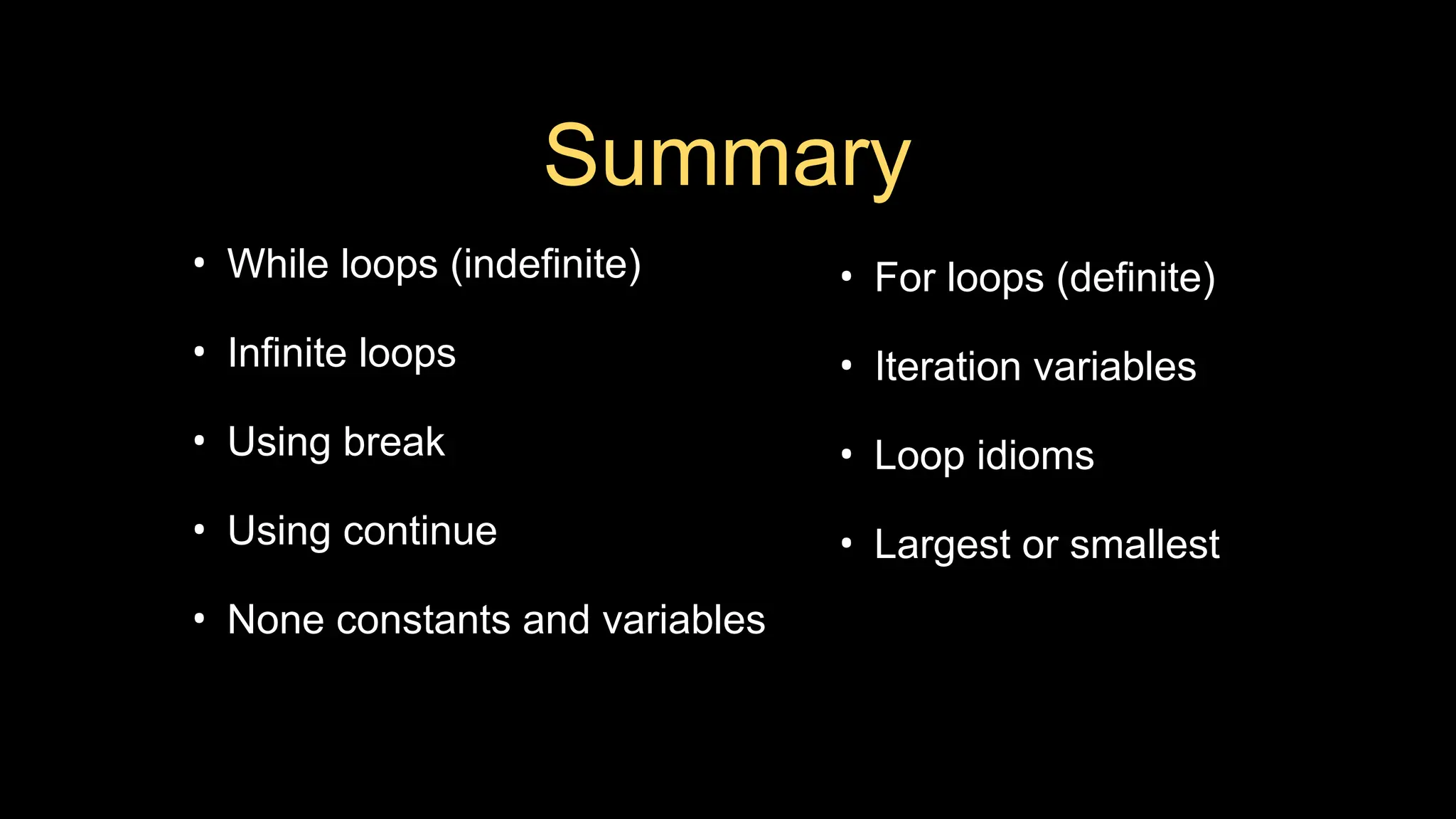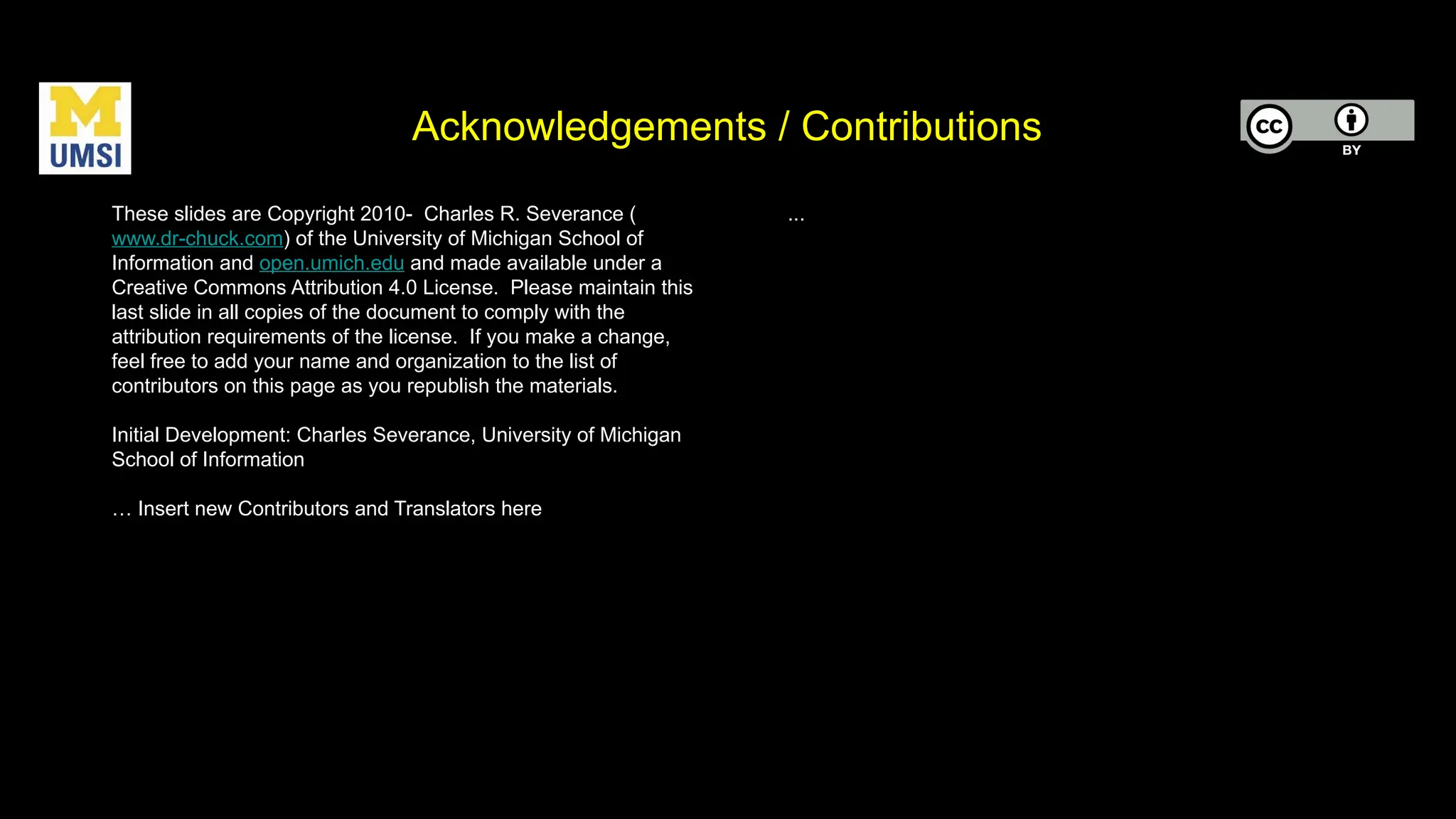This document covers loops and iteration in Python, explaining both indefinite (while) and definite (for) loops, along with key concepts such as breaking out of loops, continuing iterations, and using iteration variables. It provides examples for counting, summing numbers, finding averages, and filtering values within loops. Additionally, it discusses patterns for recognizing the largest and smallest values in a dataset and introduces essential loop idioms.
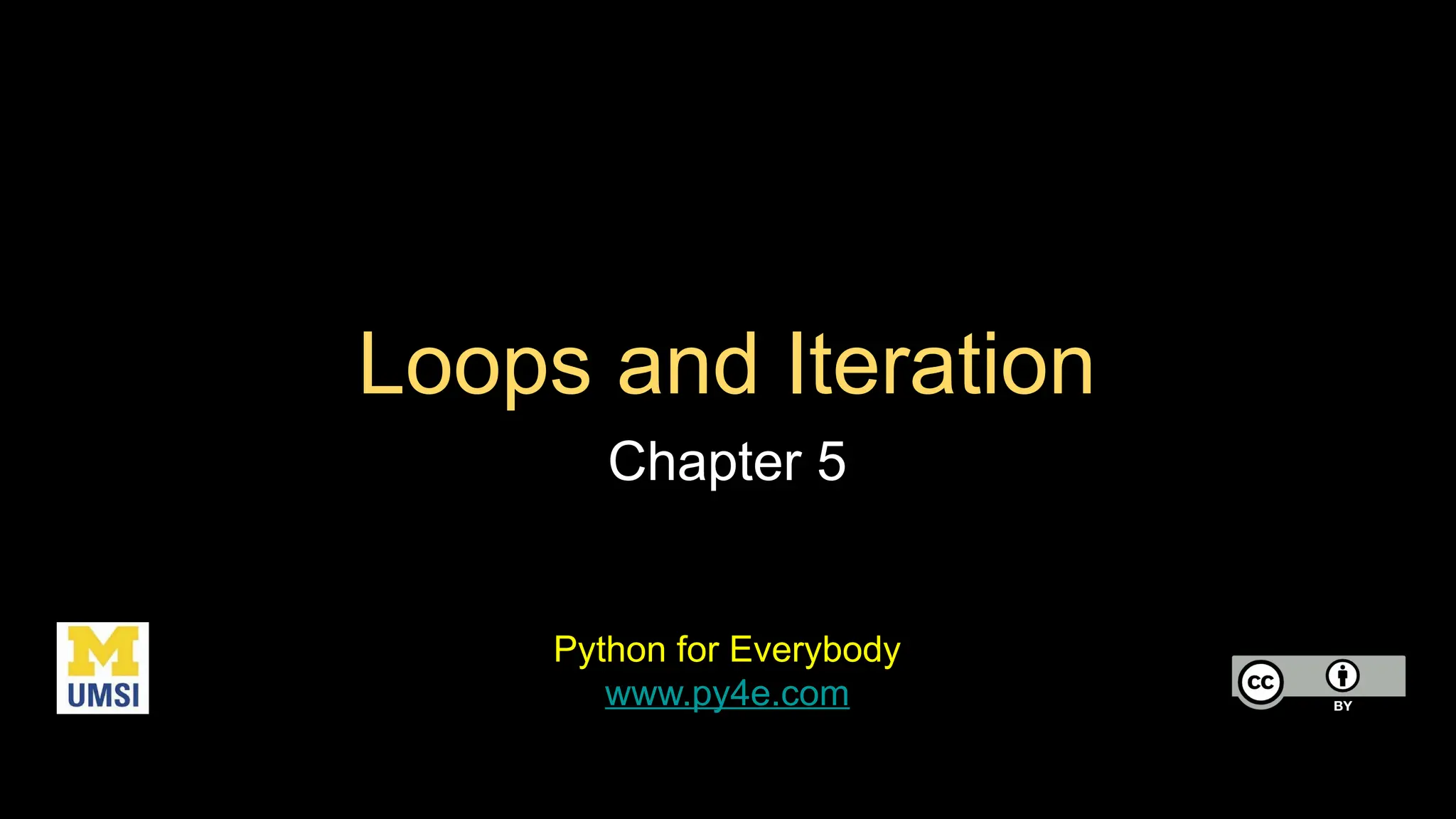
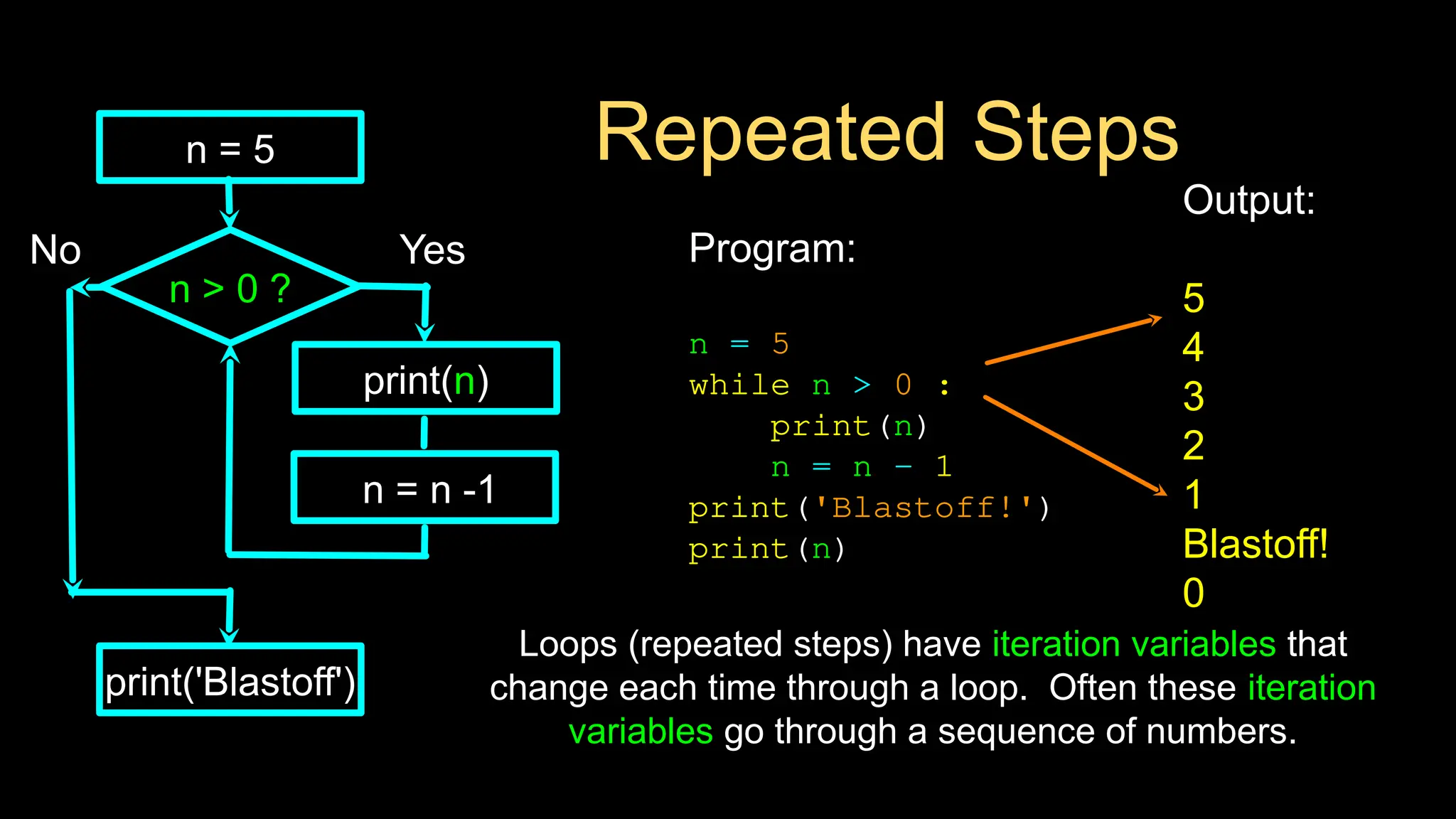
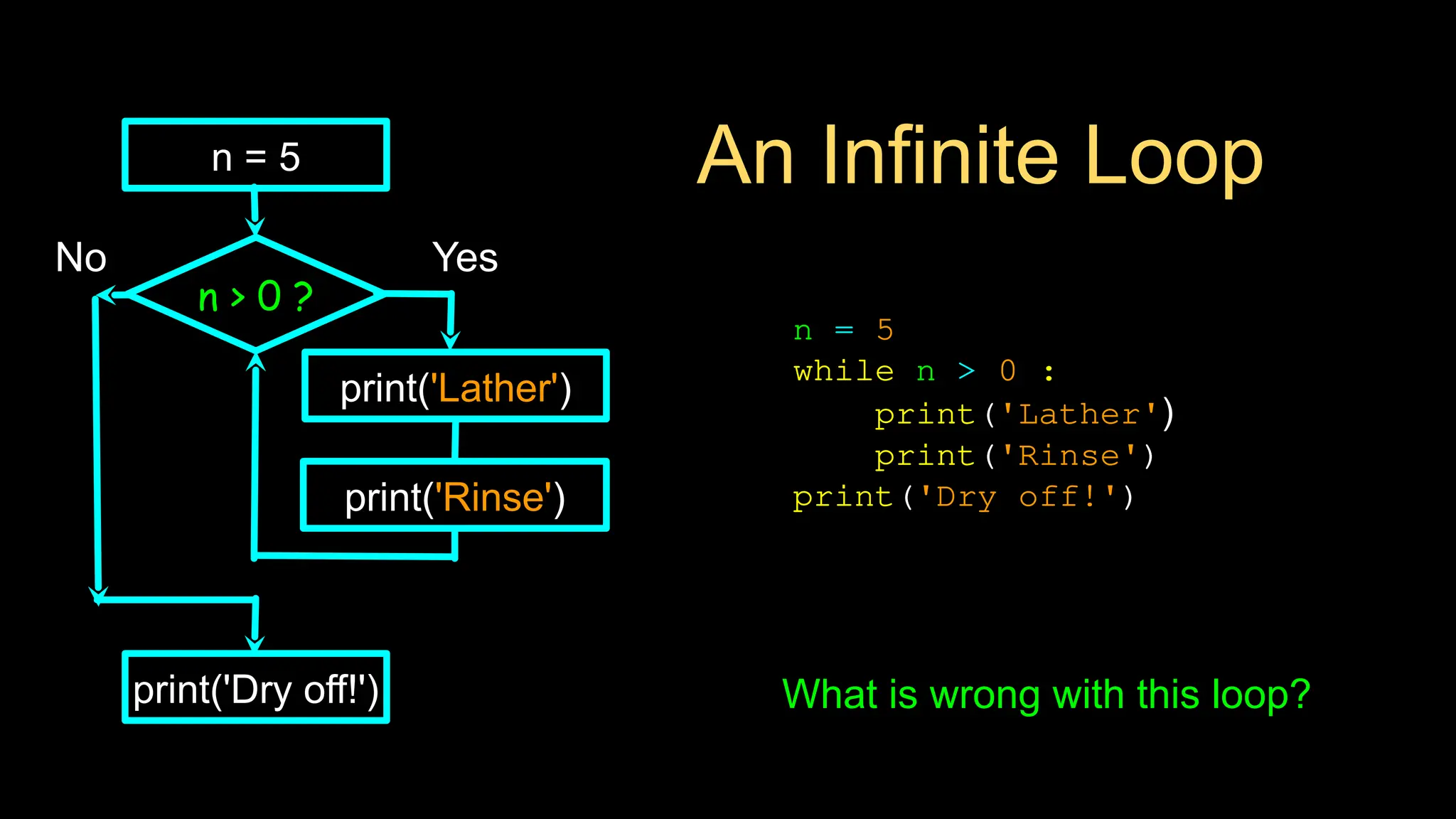
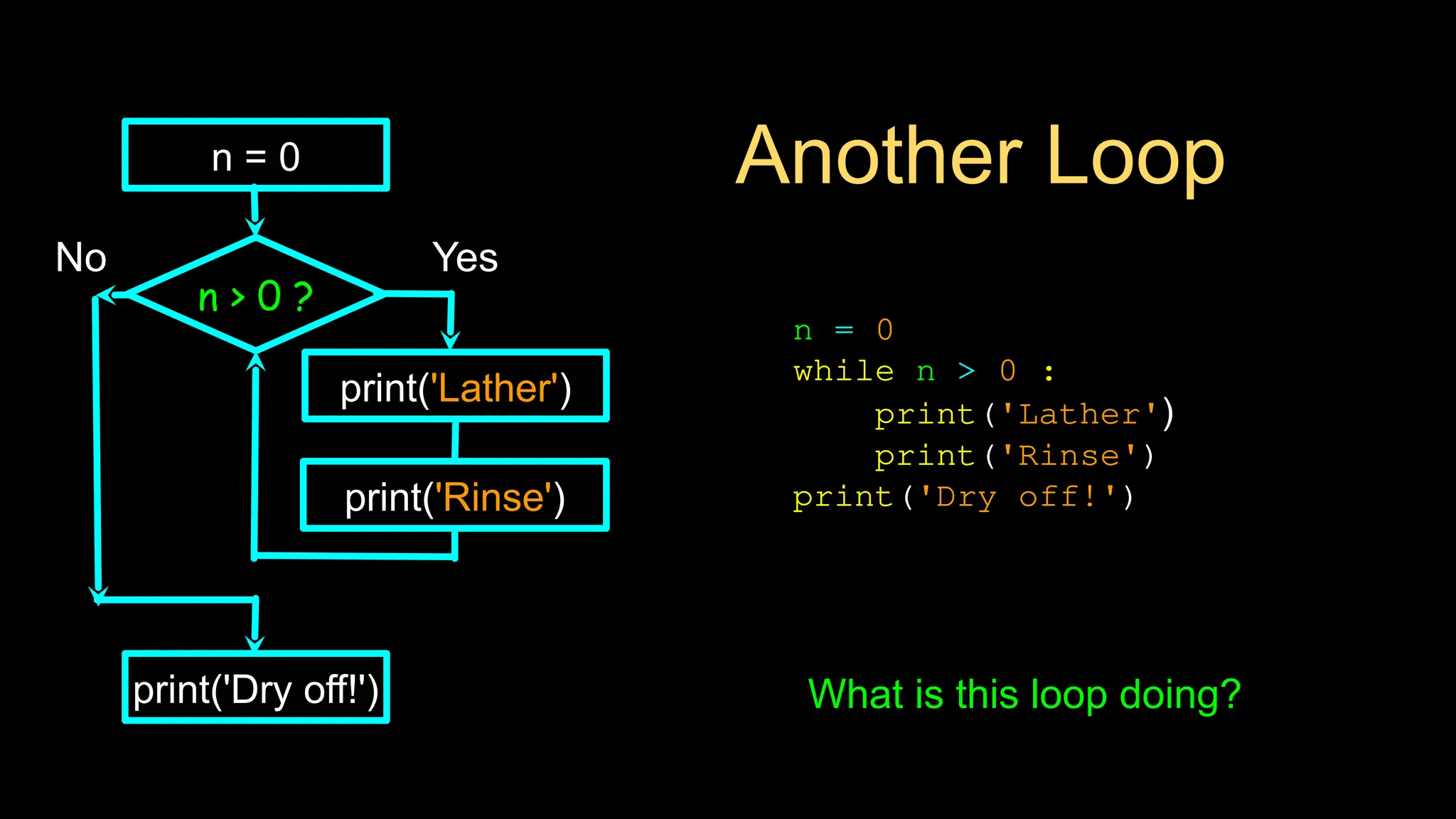
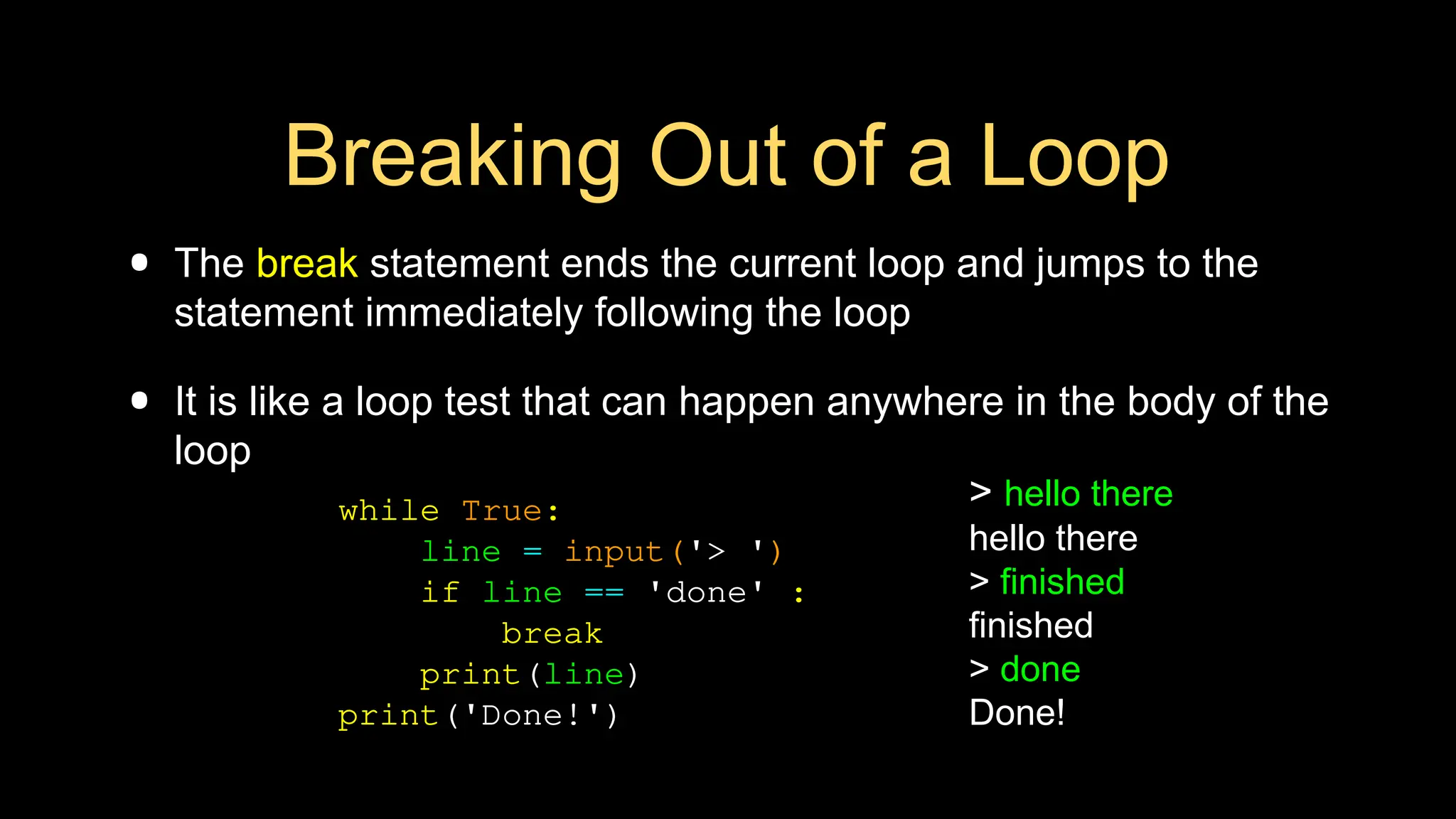
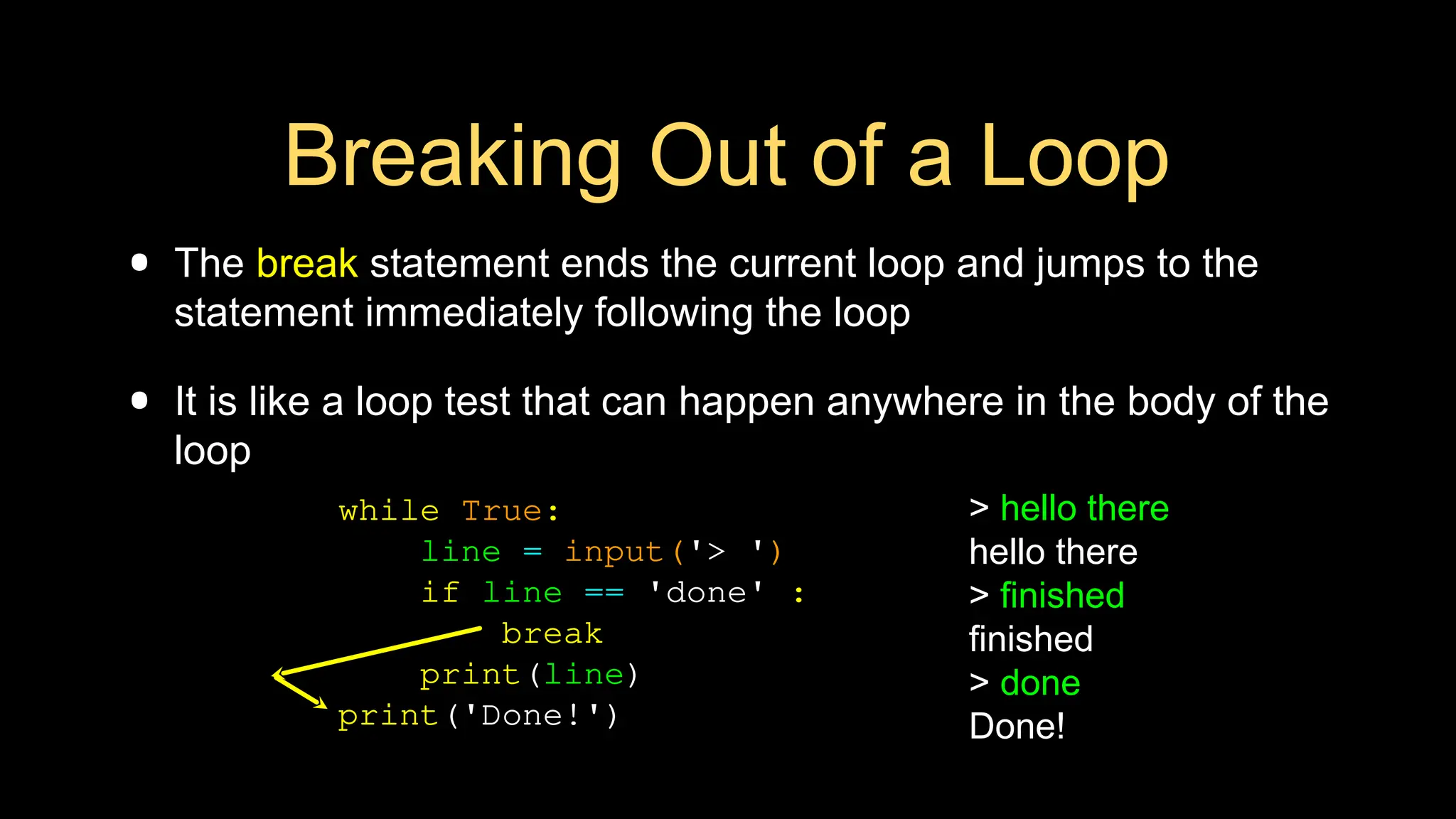
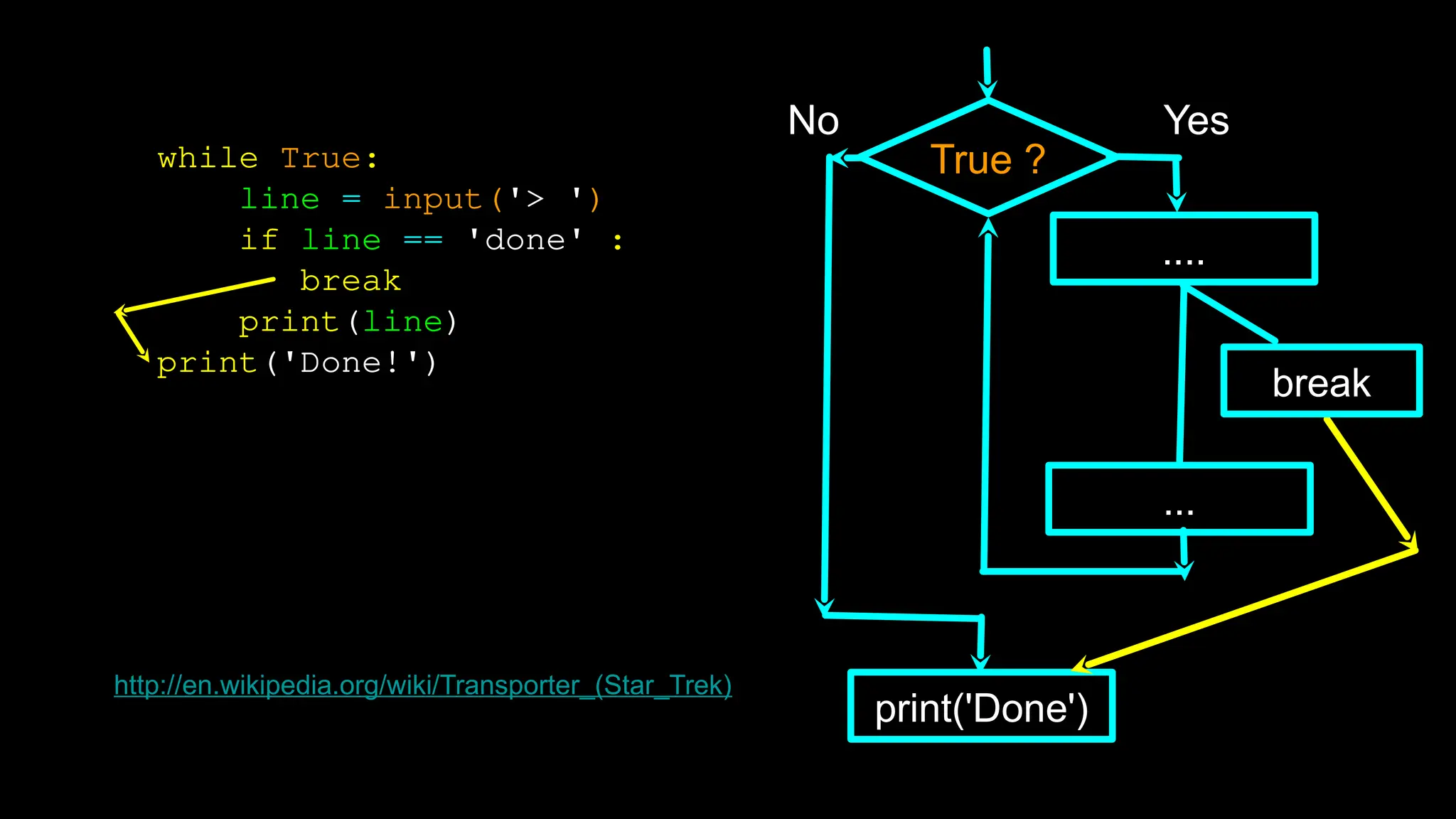
![Finishing an Iteration with
continue
The continue statement ends the current iteration and jumps to the
top of the loop and starts the next iteration
while True:
line = input('> ')
if line[0] == '#' :
continue
if line == 'done' :
break
print(line)
print('Done!')
> hello there
hello there
> # don't print this
> print this!
print this!
> done
Done!](https://image.slidesharecdn.com/pythonlearn-05-iterations-241020153812-3ca8e48e/75/Pythonlearn-05-Iterations-Lecture-Python-8-2048.jpg)
![Finishing an Iteration with
continue
The continue statement ends the current iteration and jumps to the
top of the loop and starts the next iteration
while True:
line = input('> ')
if line[0] == '#' :
continue
if line == 'done' :
break
print(line)
print('Done!')
> hello there
hello there
> # don't print this
> print this!
print this!
> done
Done!](https://image.slidesharecdn.com/pythonlearn-05-iterations-241020153812-3ca8e48e/75/Pythonlearn-05-Iterations-Lecture-Python-9-2048.jpg)
![True ?
No
print('Done')
Yes
while True:
line = raw_input('> ')
if line[0] == '#' :
continue
if line == 'done' :
break
print(line)
print('Done!')
...
....
continue](https://image.slidesharecdn.com/pythonlearn-05-iterations-241020153812-3ca8e48e/75/Pythonlearn-05-Iterations-Lecture-Python-10-2048.jpg)
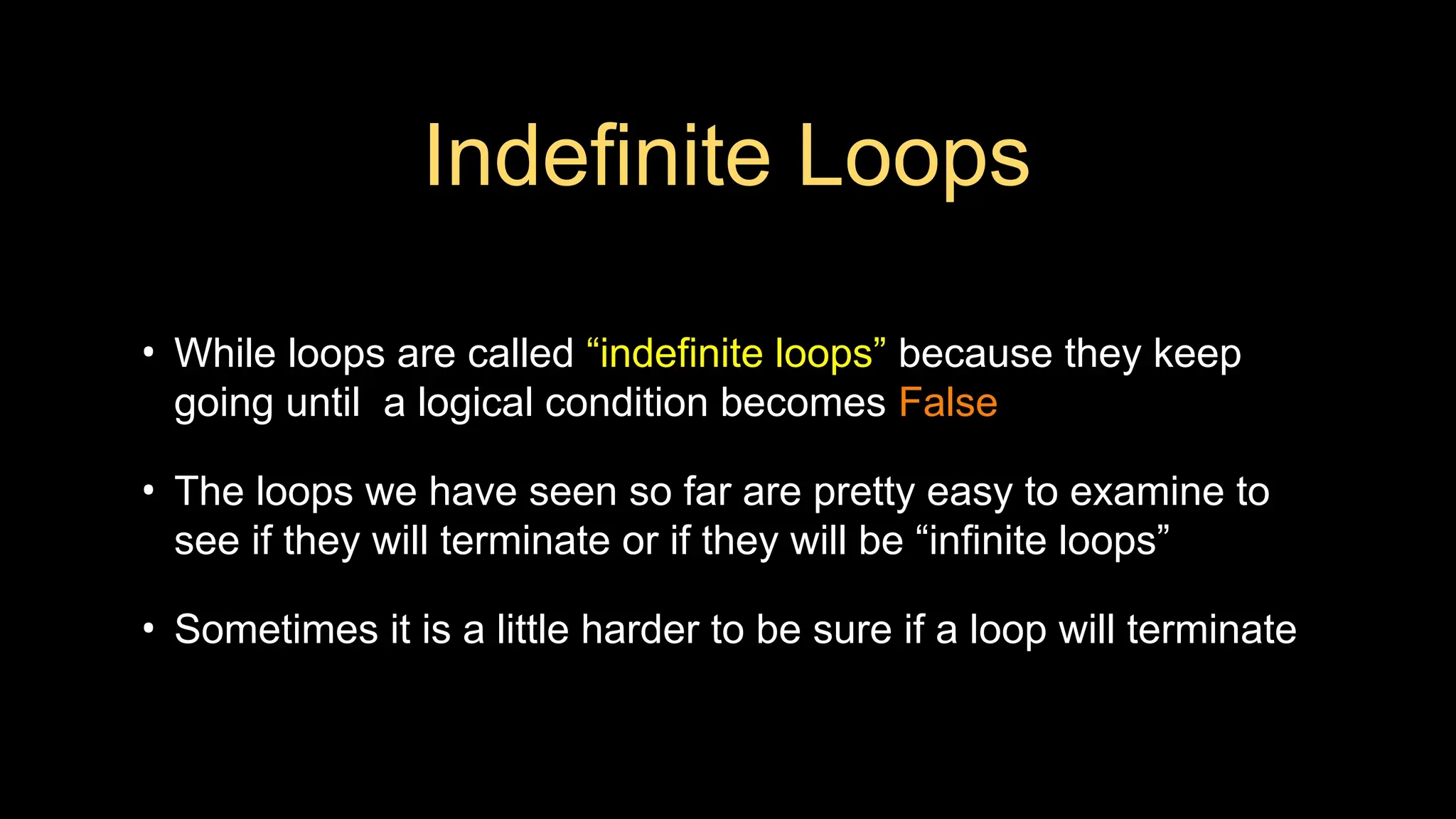
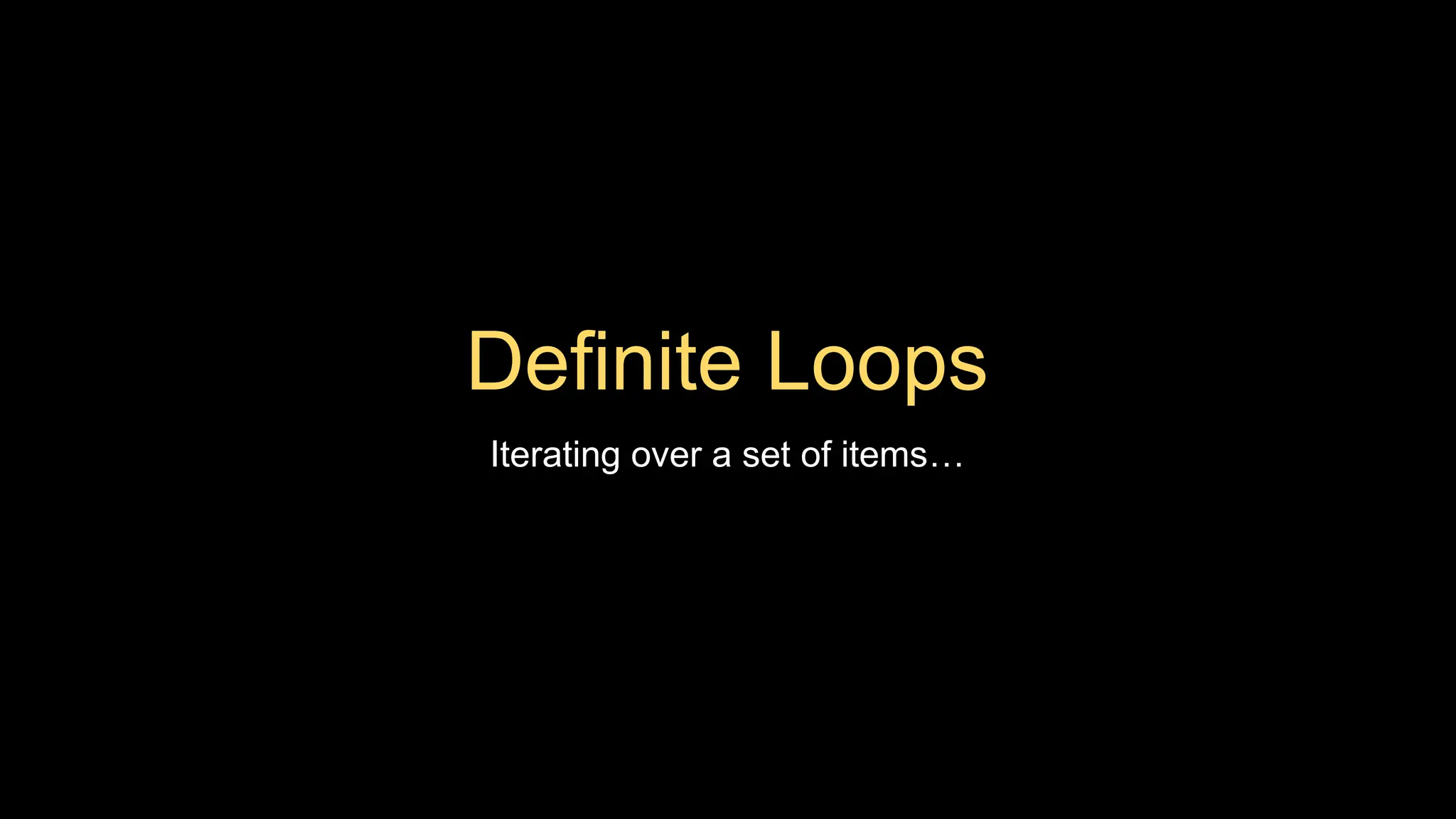
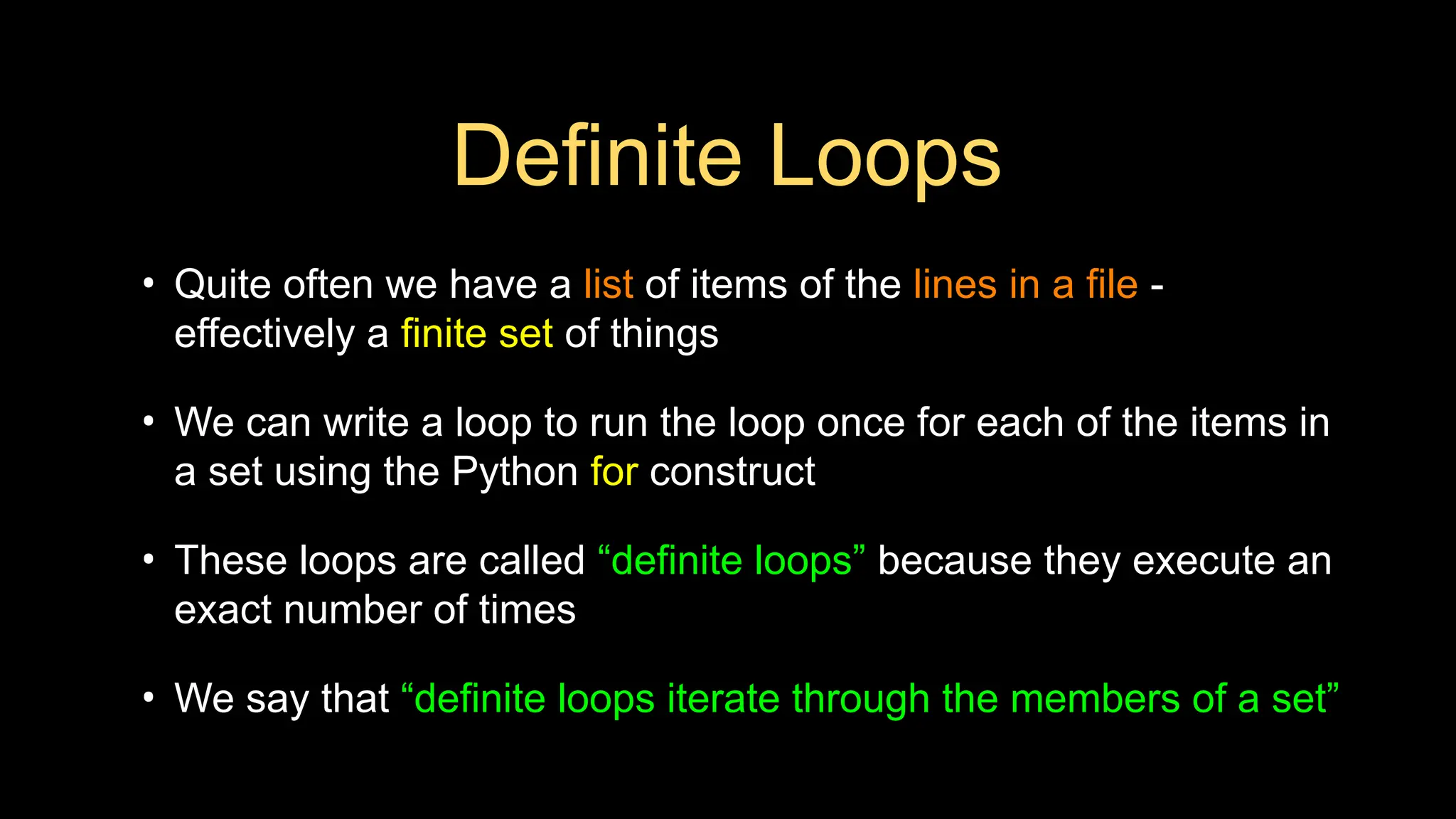
![A Simple Definite Loop
for i in [5, 4, 3, 2, 1] :
print(i)
print('Blastoff!')
5
4
3
2
1
Blastoff!](https://image.slidesharecdn.com/pythonlearn-05-iterations-241020153812-3ca8e48e/75/Pythonlearn-05-Iterations-Lecture-Python-14-2048.jpg)
![A Definite Loop with Strings
friends = ['Joseph', 'Glenn', 'Sally']
for friend in friends :
print('Happy New Year:', friend)
print('Done!')
Happy New Year: Joseph
Happy New Year: Glenn
Happy New Year: Sally
Done!](https://image.slidesharecdn.com/pythonlearn-05-iterations-241020153812-3ca8e48e/75/Pythonlearn-05-Iterations-Lecture-Python-15-2048.jpg)
![A Simple Definite Loop
for i in [5, 4, 3, 2, 1] :
print(i)
print('Blastoff!')
5
4
3
2
1
Blastoff!
Done?
Yes
print('Blast off!')
print(i)
No
Move i ahead
Definite loops (for loops) have explicit iteration variables
that change each time through a loop. These iteration
variables move through the sequence or set.](https://image.slidesharecdn.com/pythonlearn-05-iterations-241020153812-3ca8e48e/75/Pythonlearn-05-Iterations-Lecture-Python-16-2048.jpg)
![Looking at in...
• The iteration variable
“iterates” through the
sequence (ordered set)
• The block (body) of code is
executed once for each
value in the sequence
• The iteration variable moves
through all of the values in
the sequence
for i in [5, 4, 3, 2, 1] :
print(i)
Iteration variable
Five-element
sequence](https://image.slidesharecdn.com/pythonlearn-05-iterations-241020153812-3ca8e48e/75/Pythonlearn-05-Iterations-Lecture-Python-17-2048.jpg)
![Done?
Yes
print(i)
No
Move i ahead
• The iteration variable “iterates”
through the sequence (ordered
set)
• The block (body) of code is
executed once for each value in
the sequence
• The iteration variable moves
through all of the values in the
sequence
for i in [5, 4, 3, 2, 1] :
print(i)](https://image.slidesharecdn.com/pythonlearn-05-iterations-241020153812-3ca8e48e/75/Pythonlearn-05-Iterations-Lecture-Python-18-2048.jpg)
![print(i)
i = 5
print(i)
i = 4
print(i)
i = 3
print(i)
i = 2
print(i)
i = 1
for i in [5, 4, 3, 2, 1] :
print(i)
Done?
Yes
print(i)
No
Move i ahead](https://image.slidesharecdn.com/pythonlearn-05-iterations-241020153812-3ca8e48e/75/Pythonlearn-05-Iterations-Lecture-Python-19-2048.jpg)
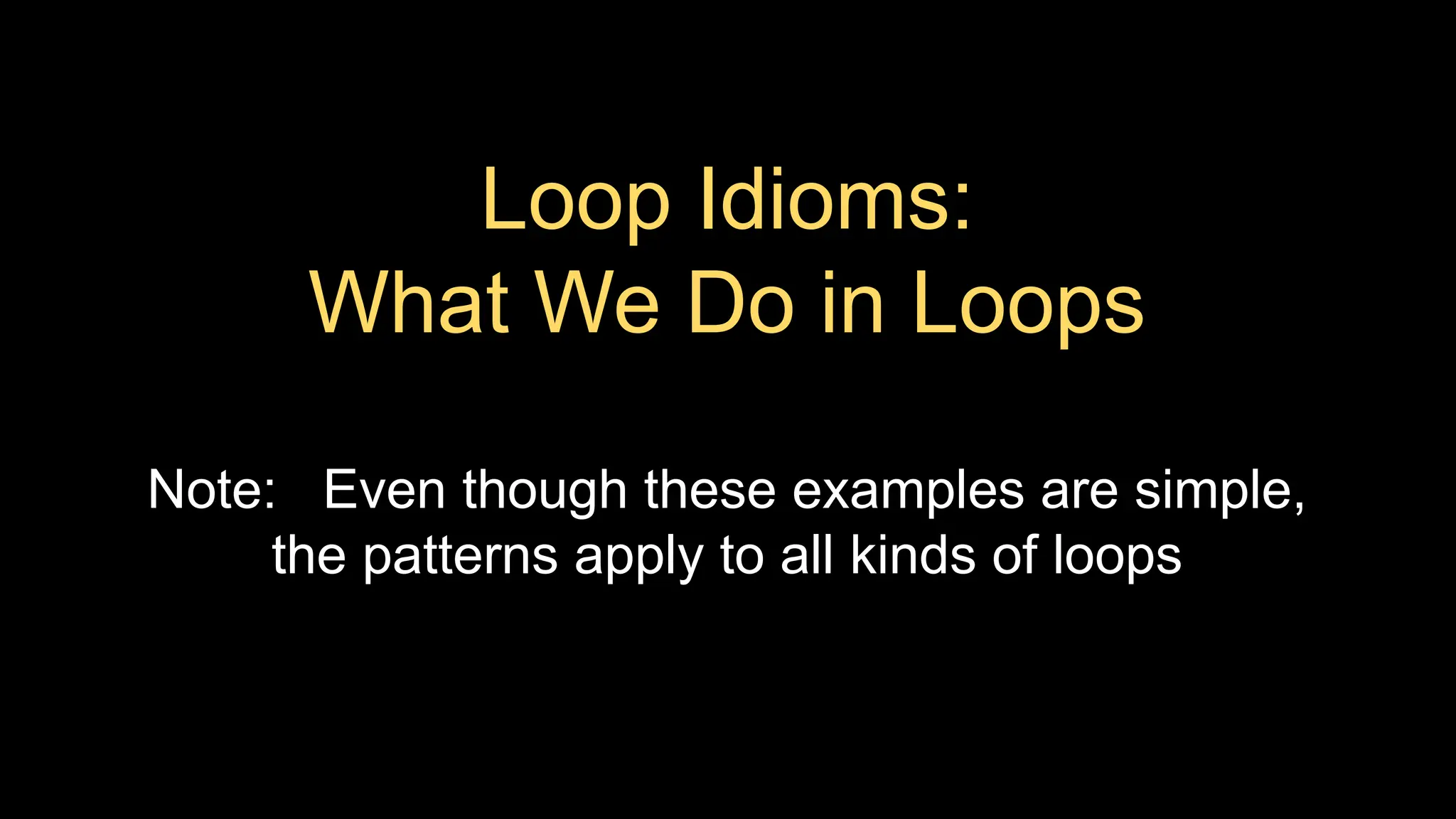
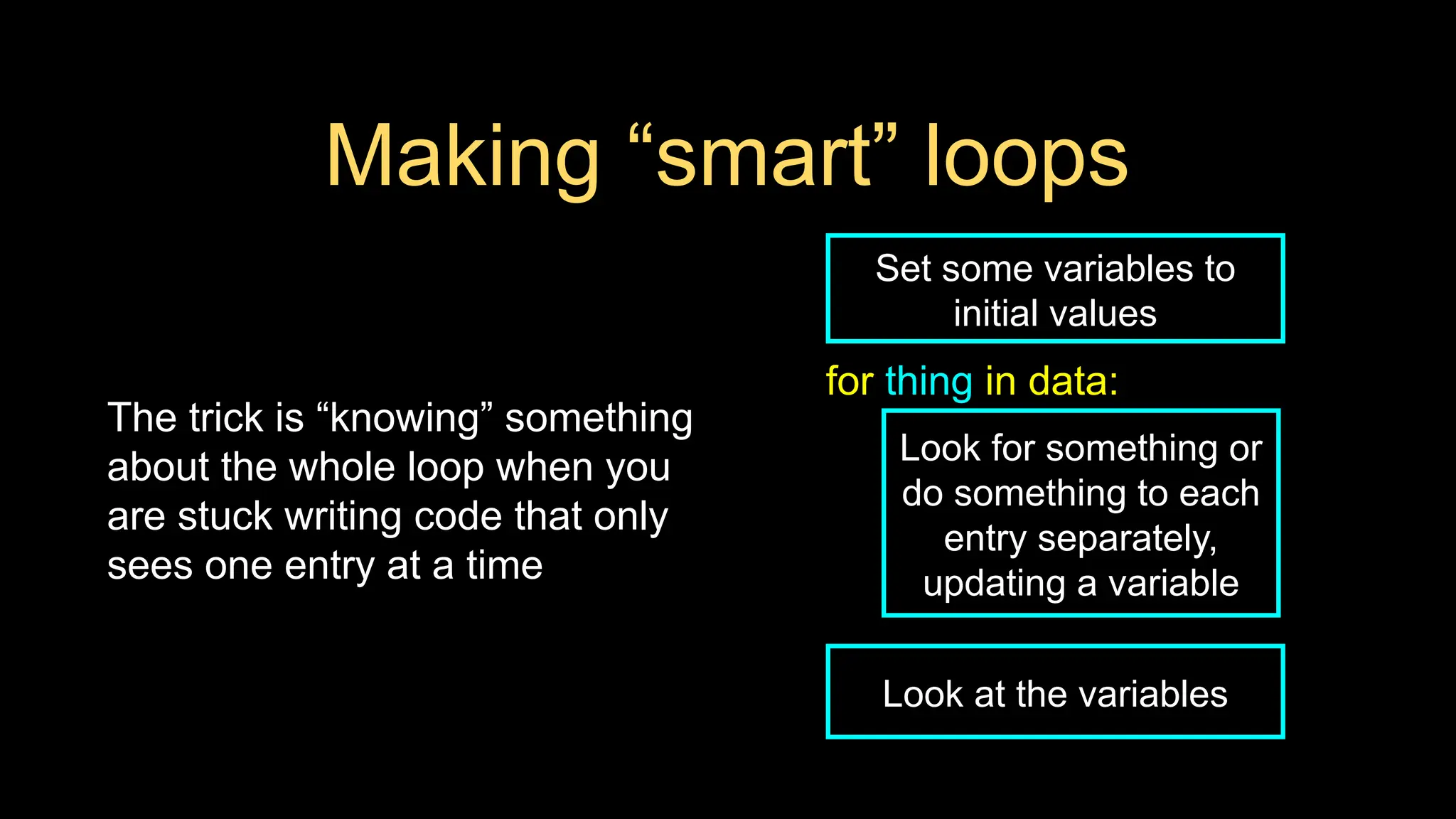
![Looping Through a Set
print('Before')
for thing in [9, 41, 12, 3, 74, 15] :
print(thing)
print('After')
$ python basicloop.py
Before
9
41
12
3
74
15
After](https://image.slidesharecdn.com/pythonlearn-05-iterations-241020153812-3ca8e48e/75/Pythonlearn-05-Iterations-Lecture-Python-22-2048.jpg)
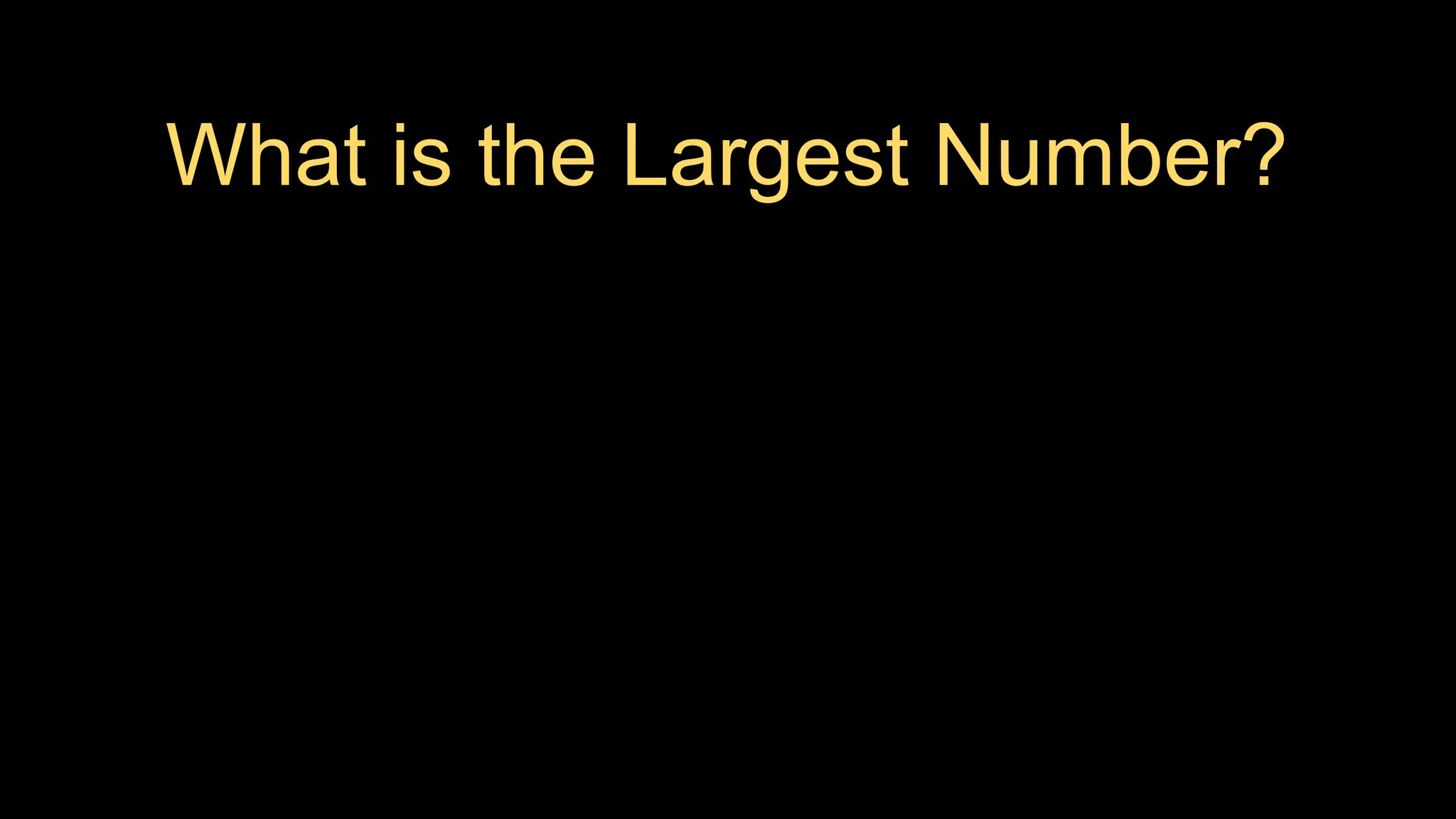
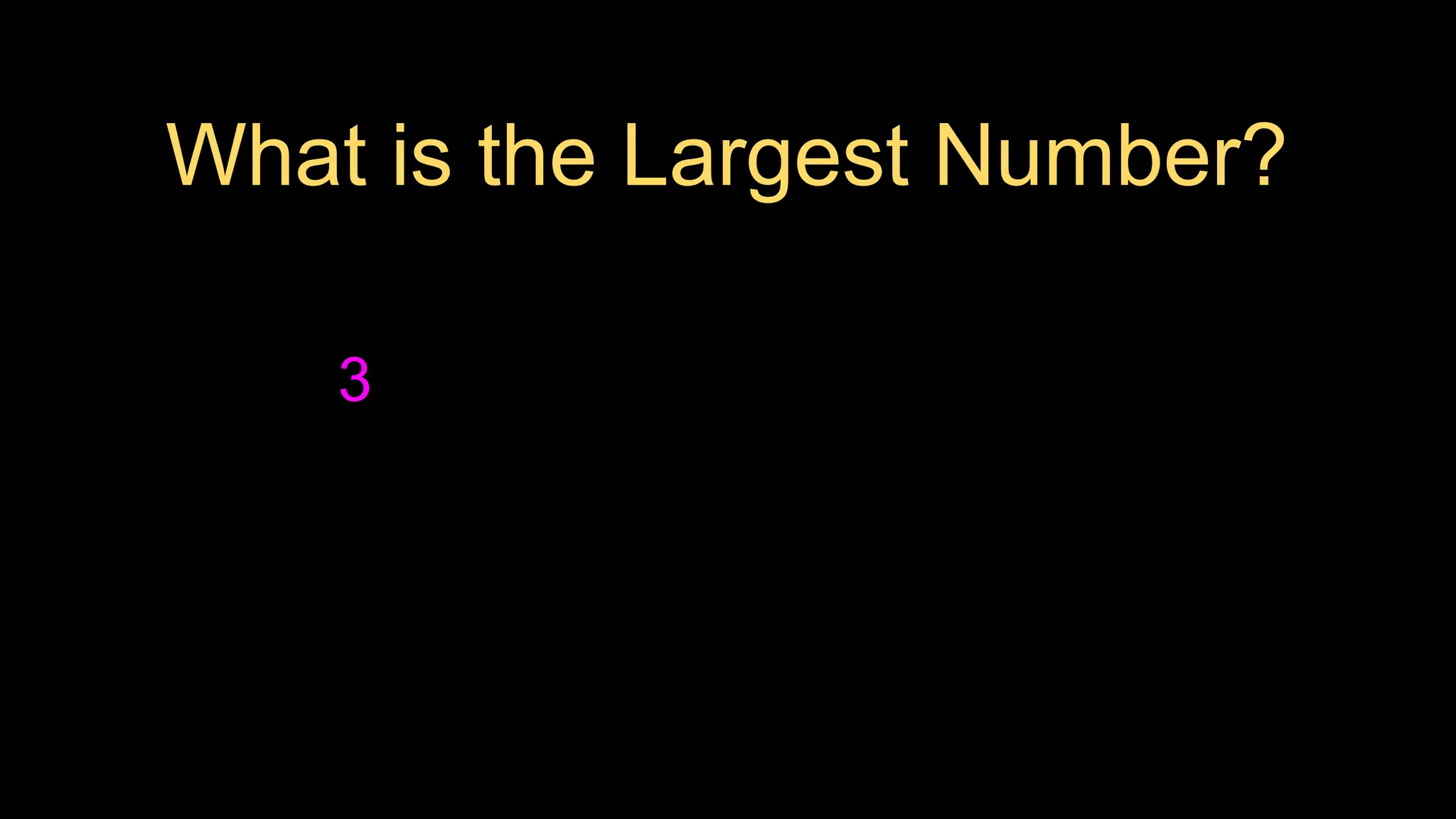
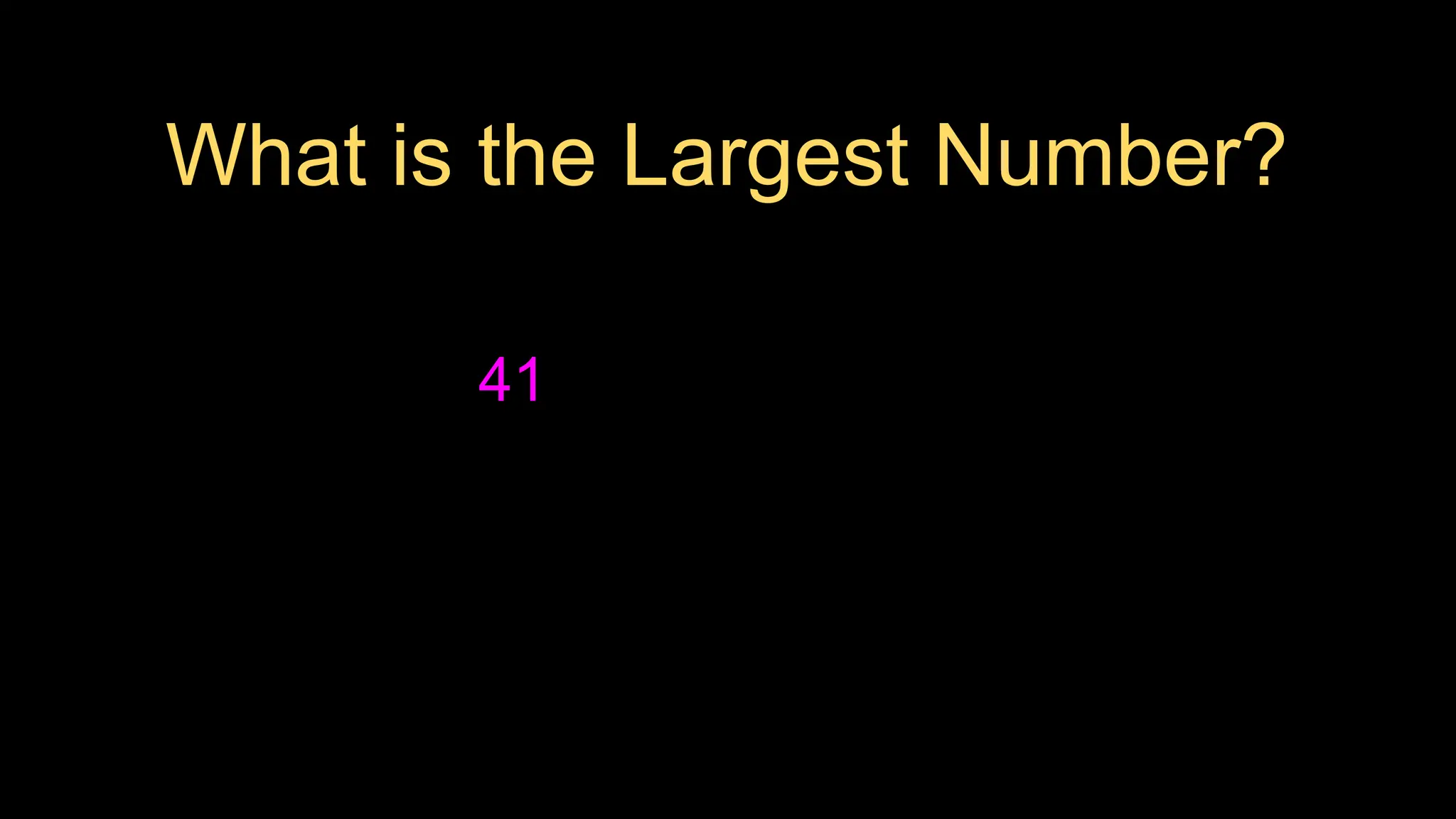
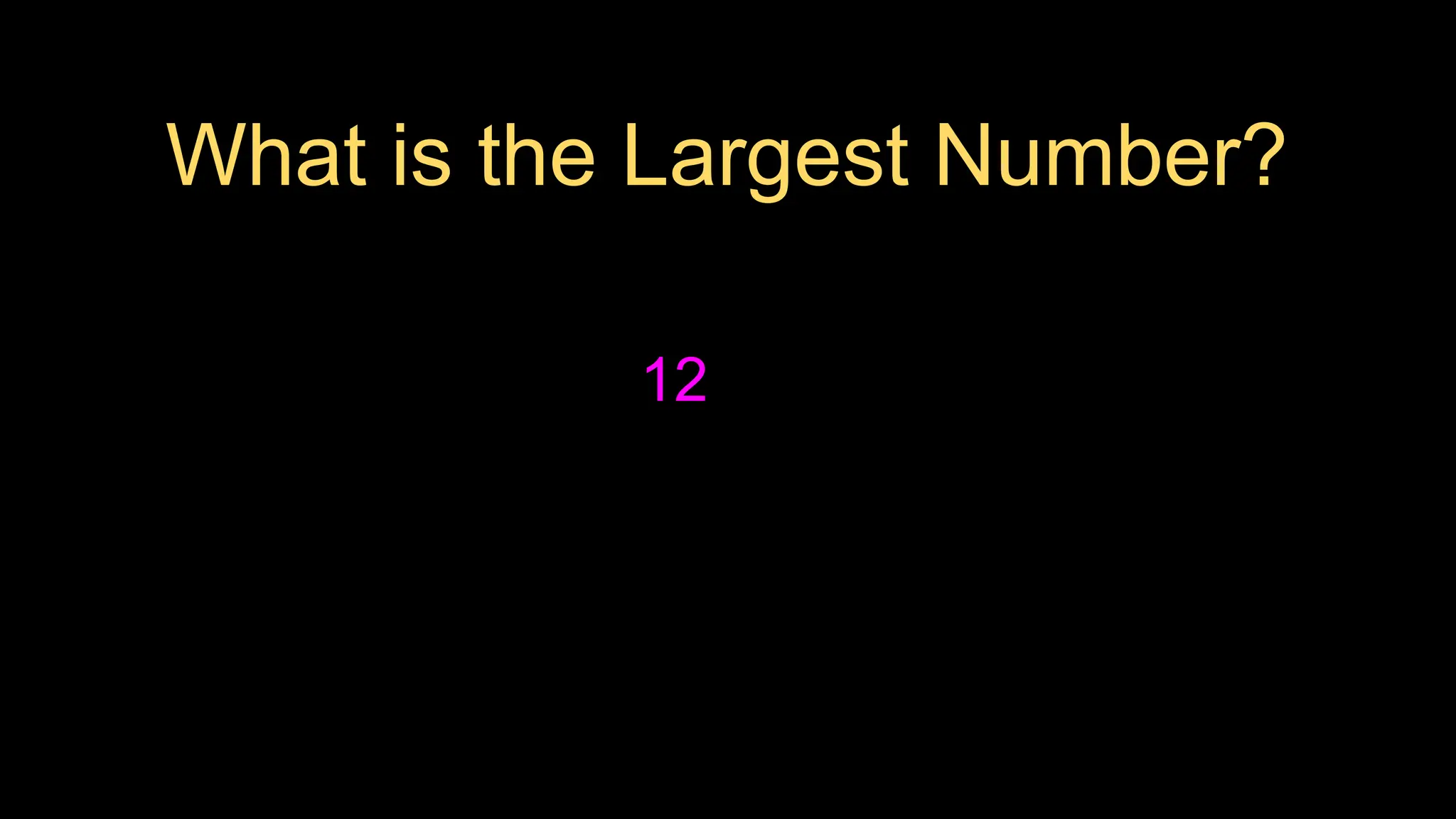
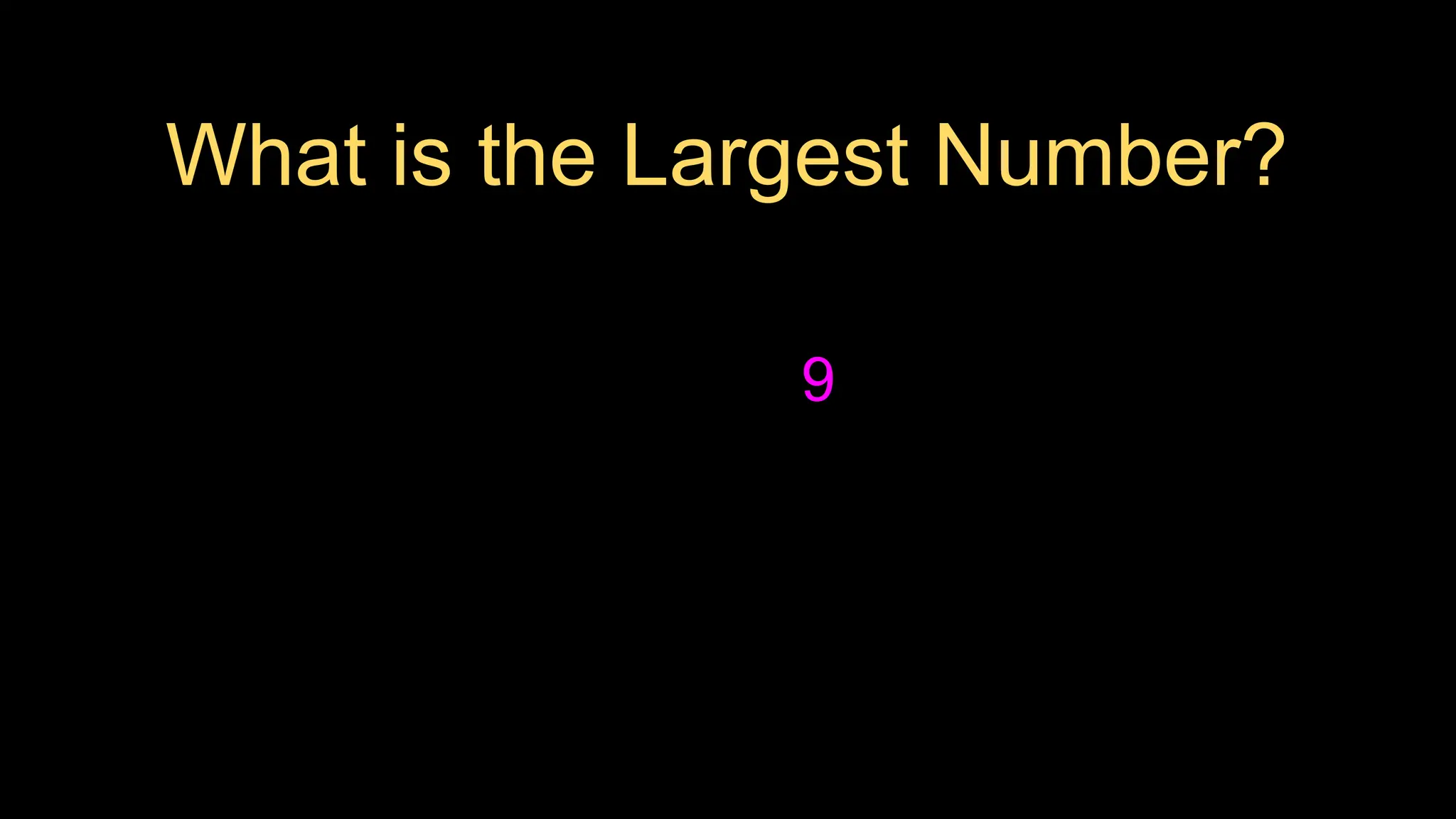
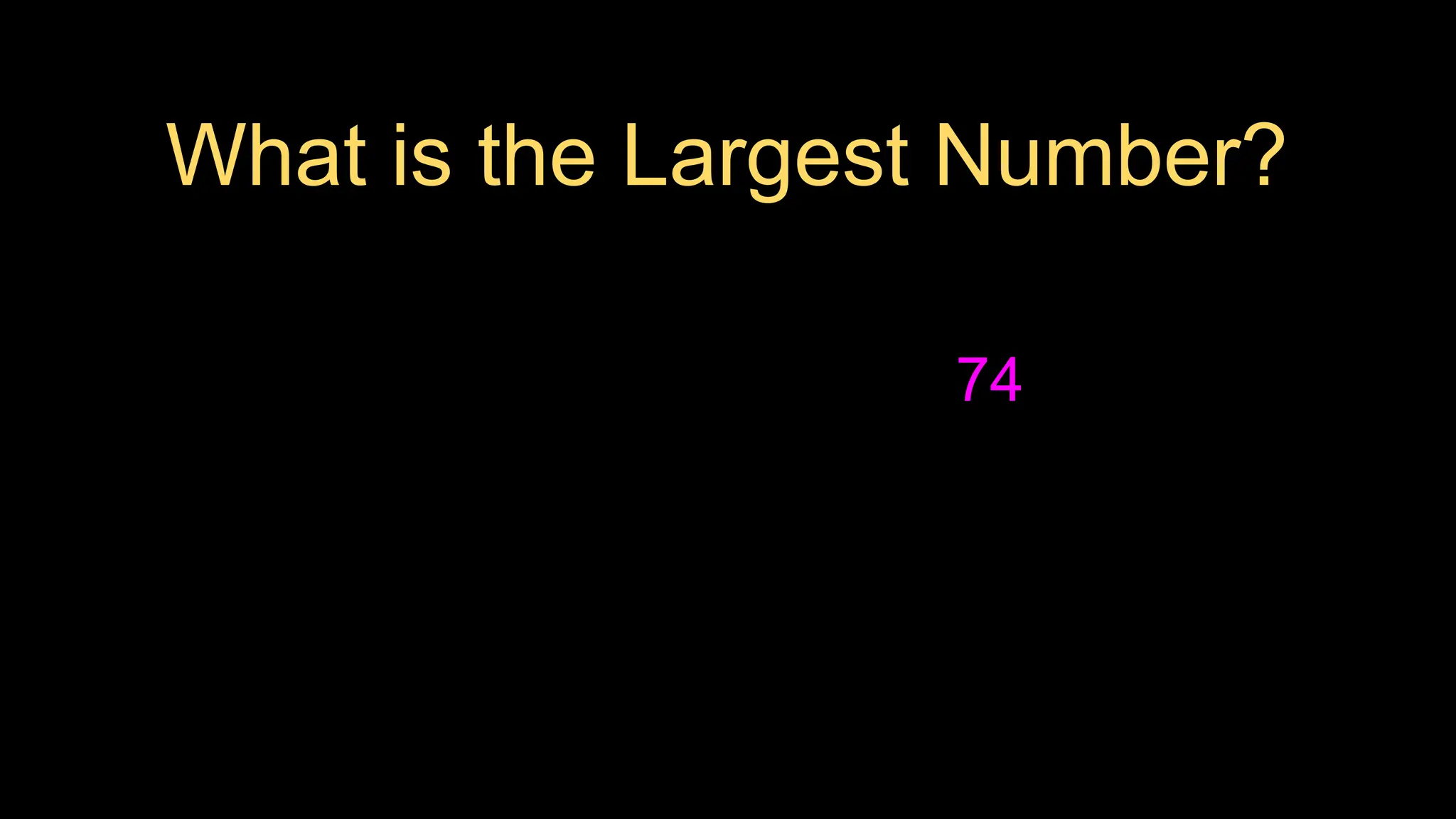

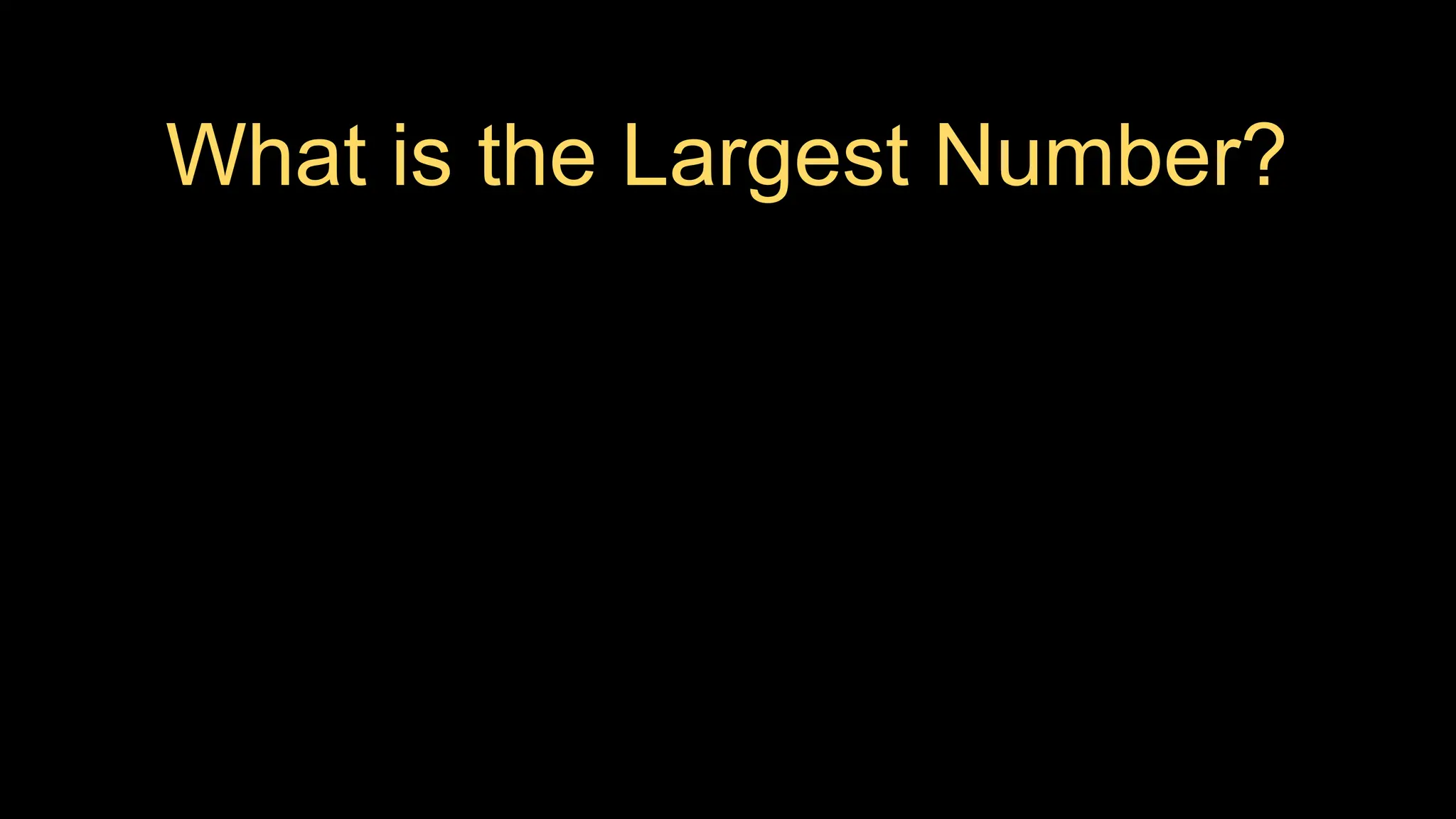
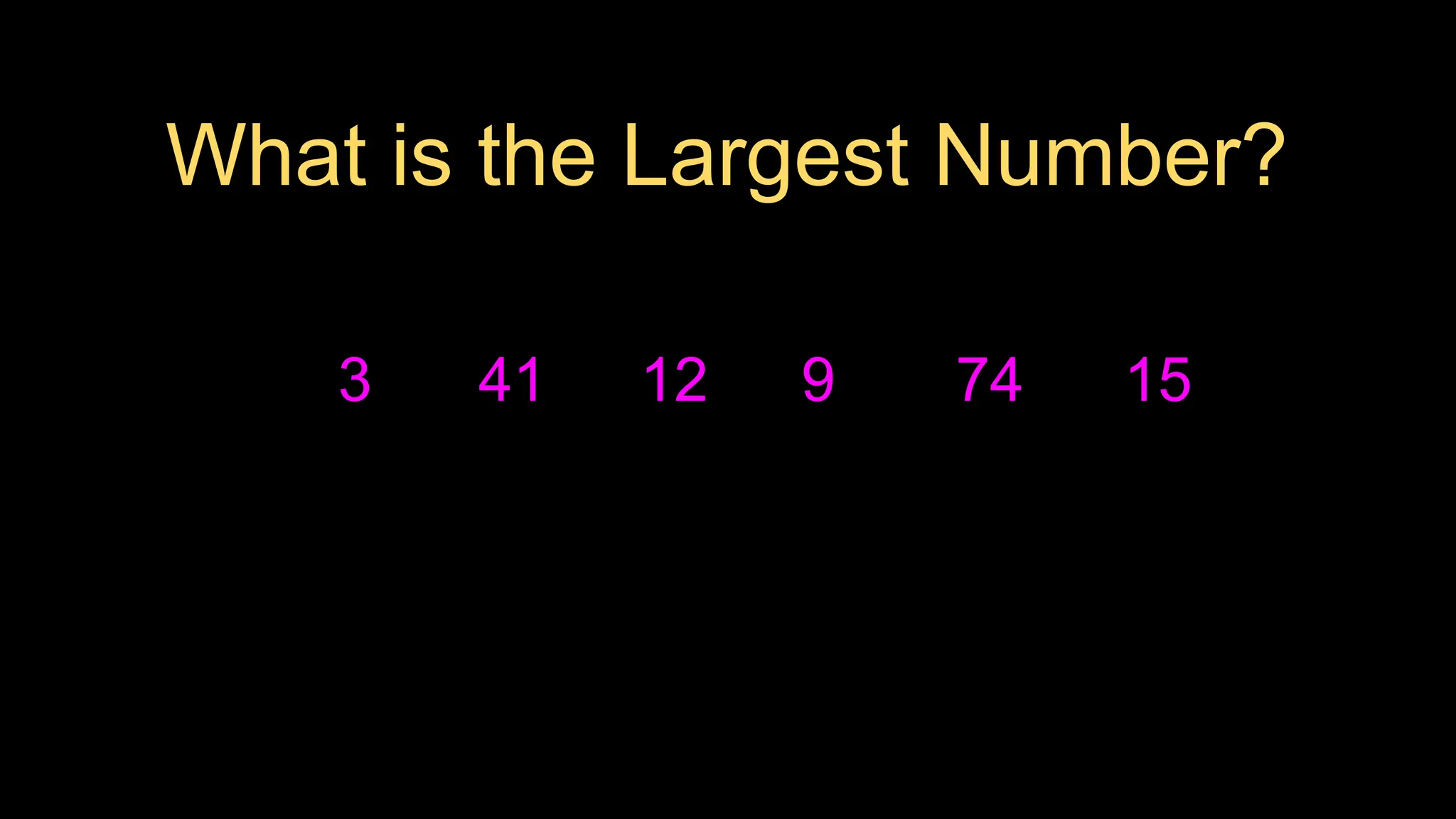
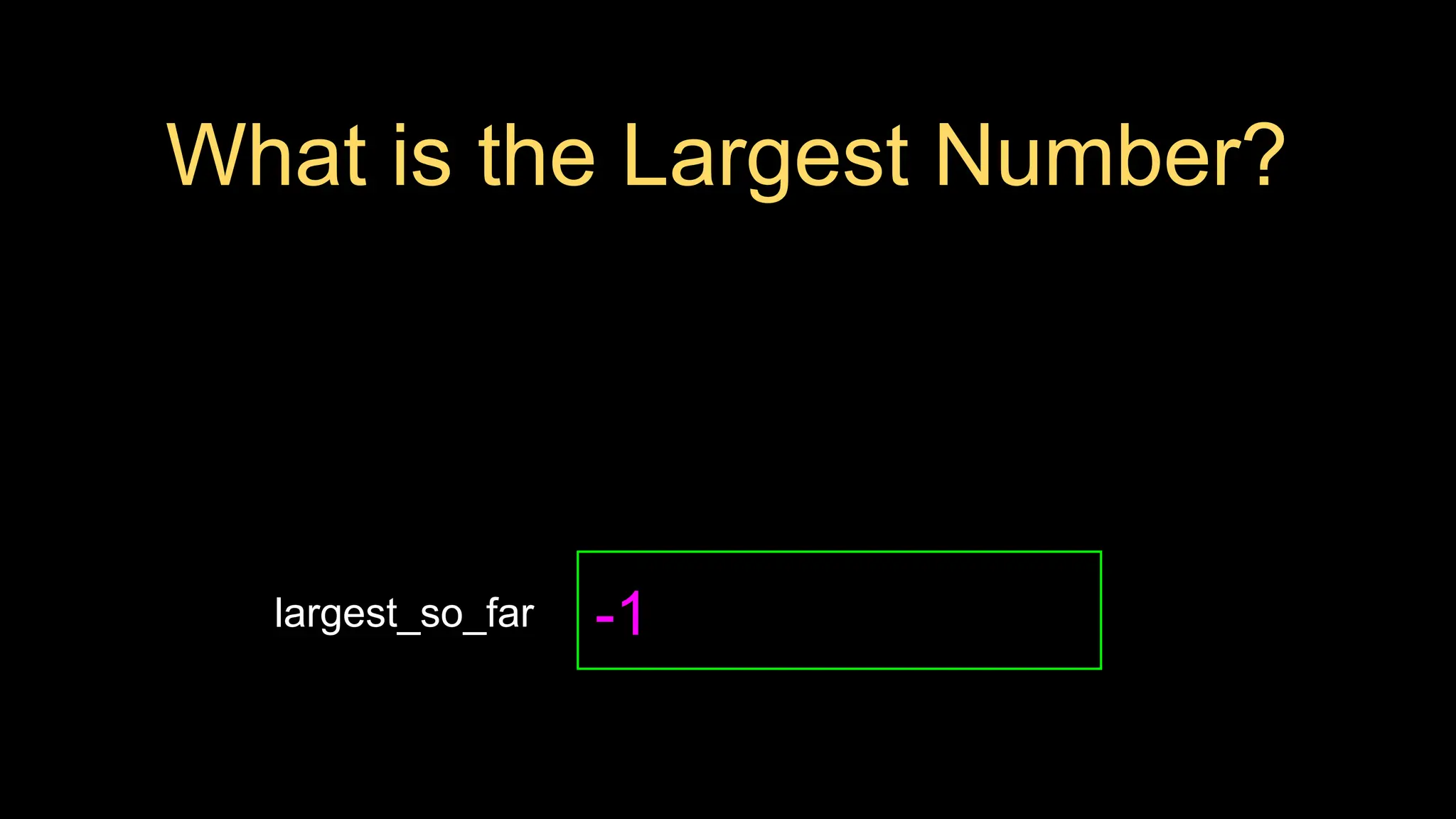
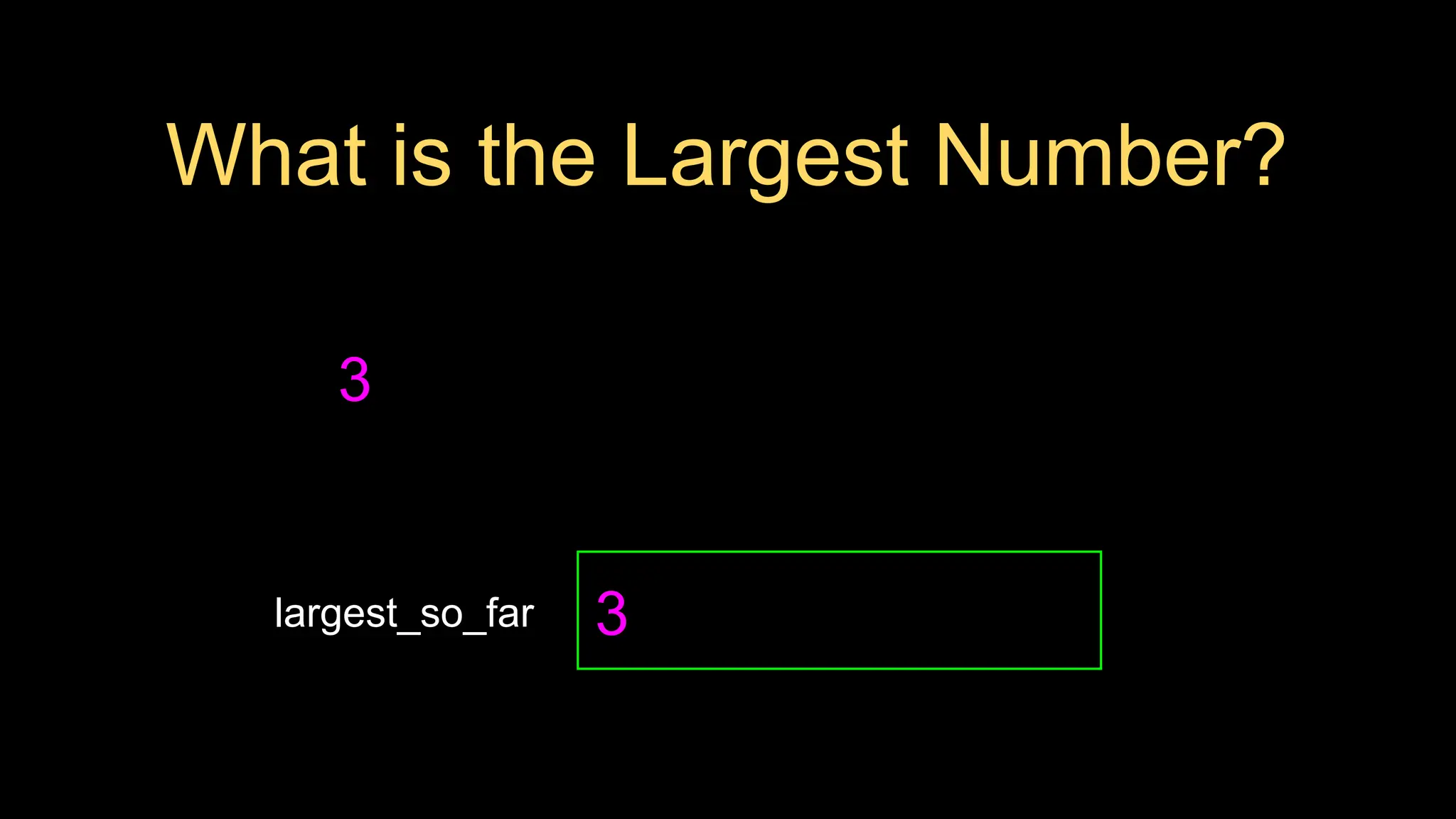
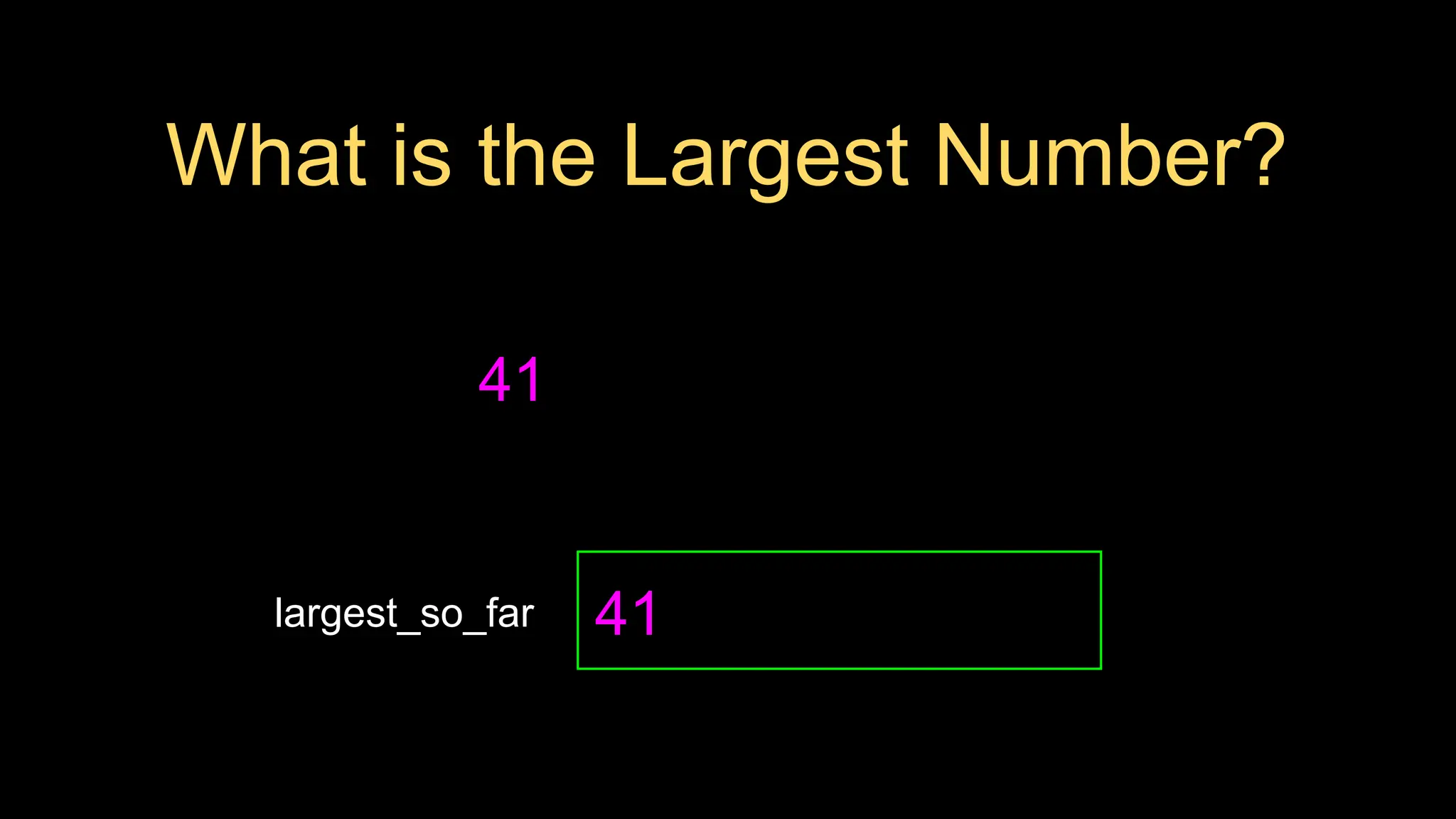
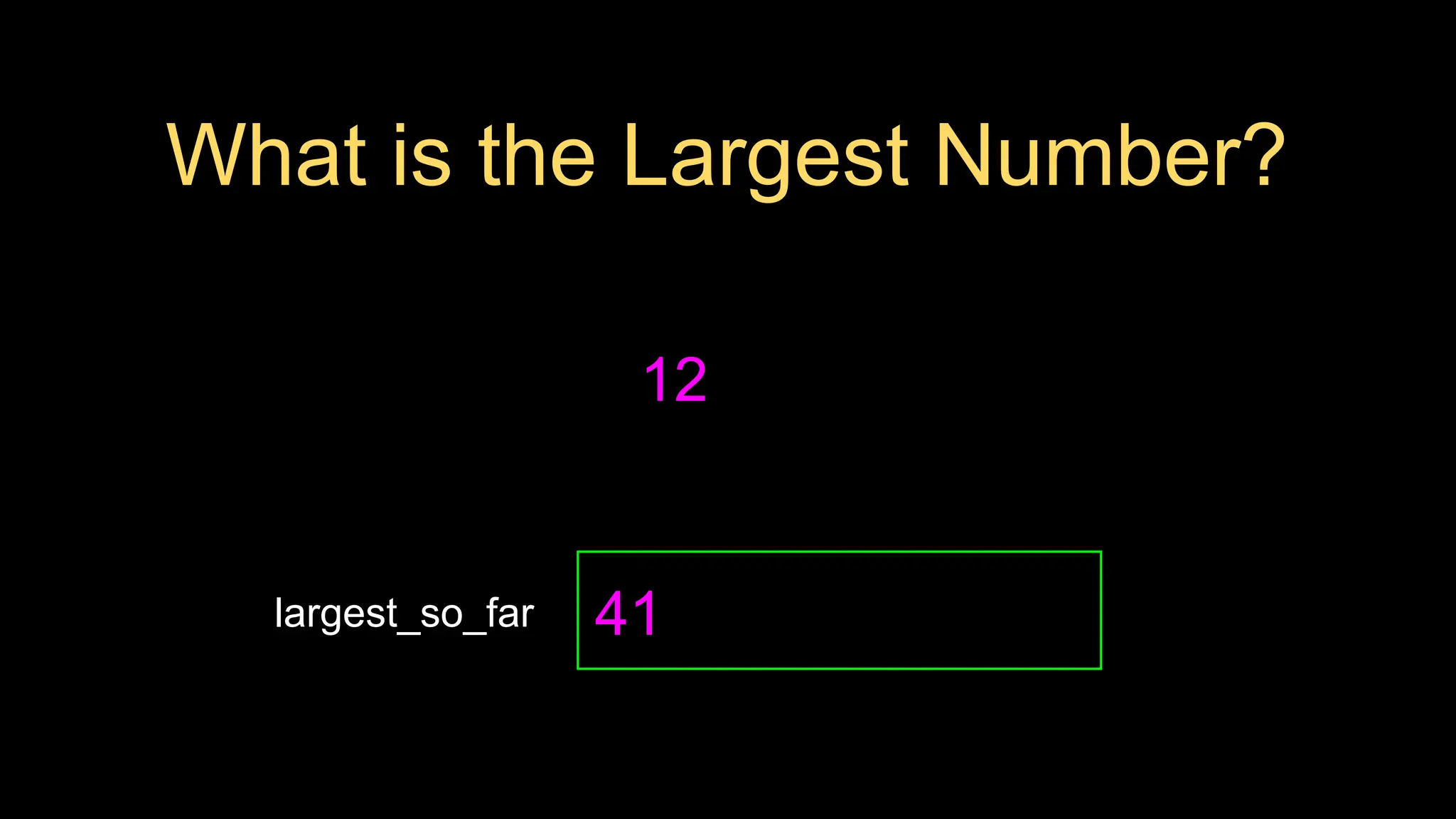
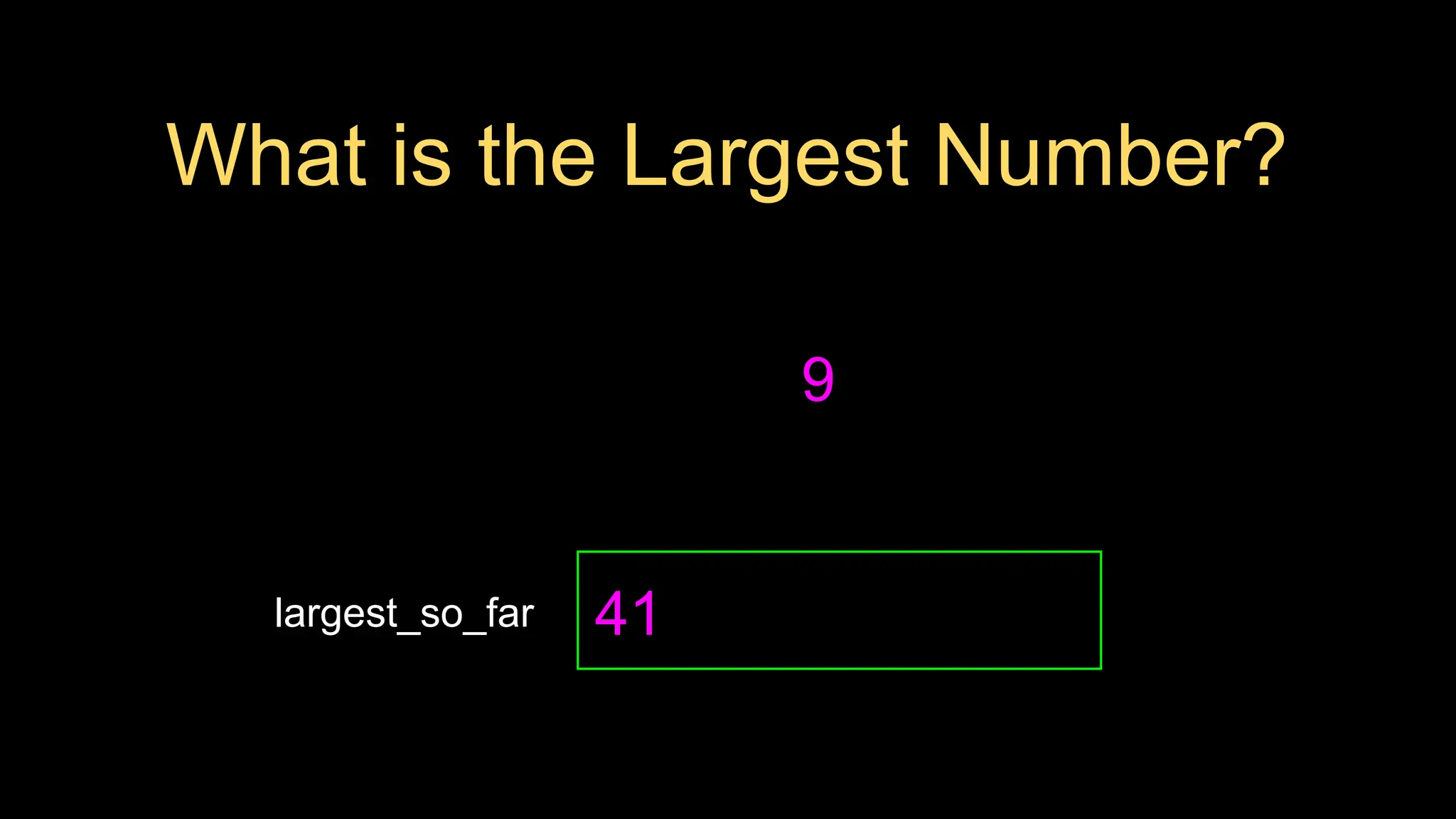
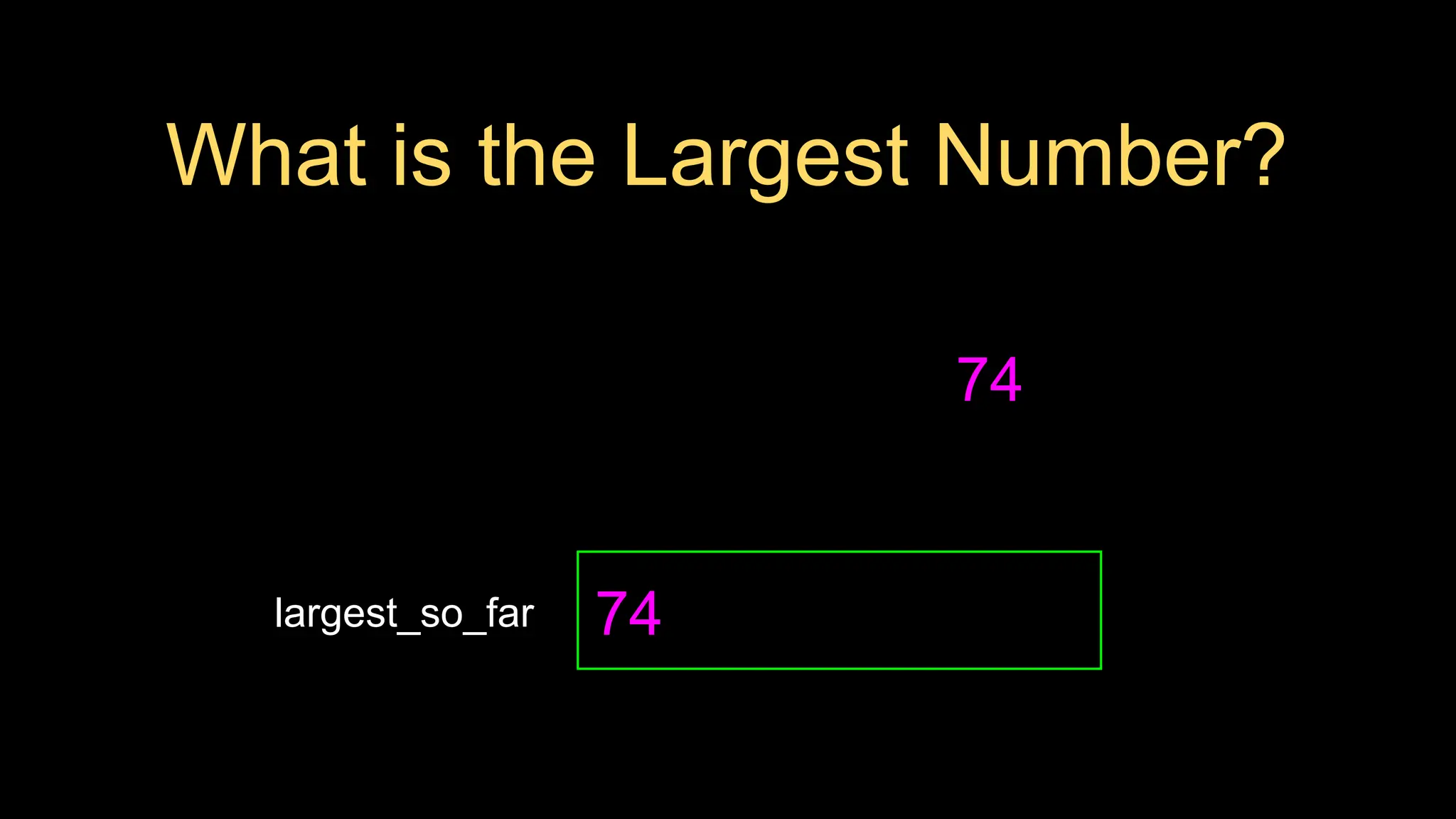
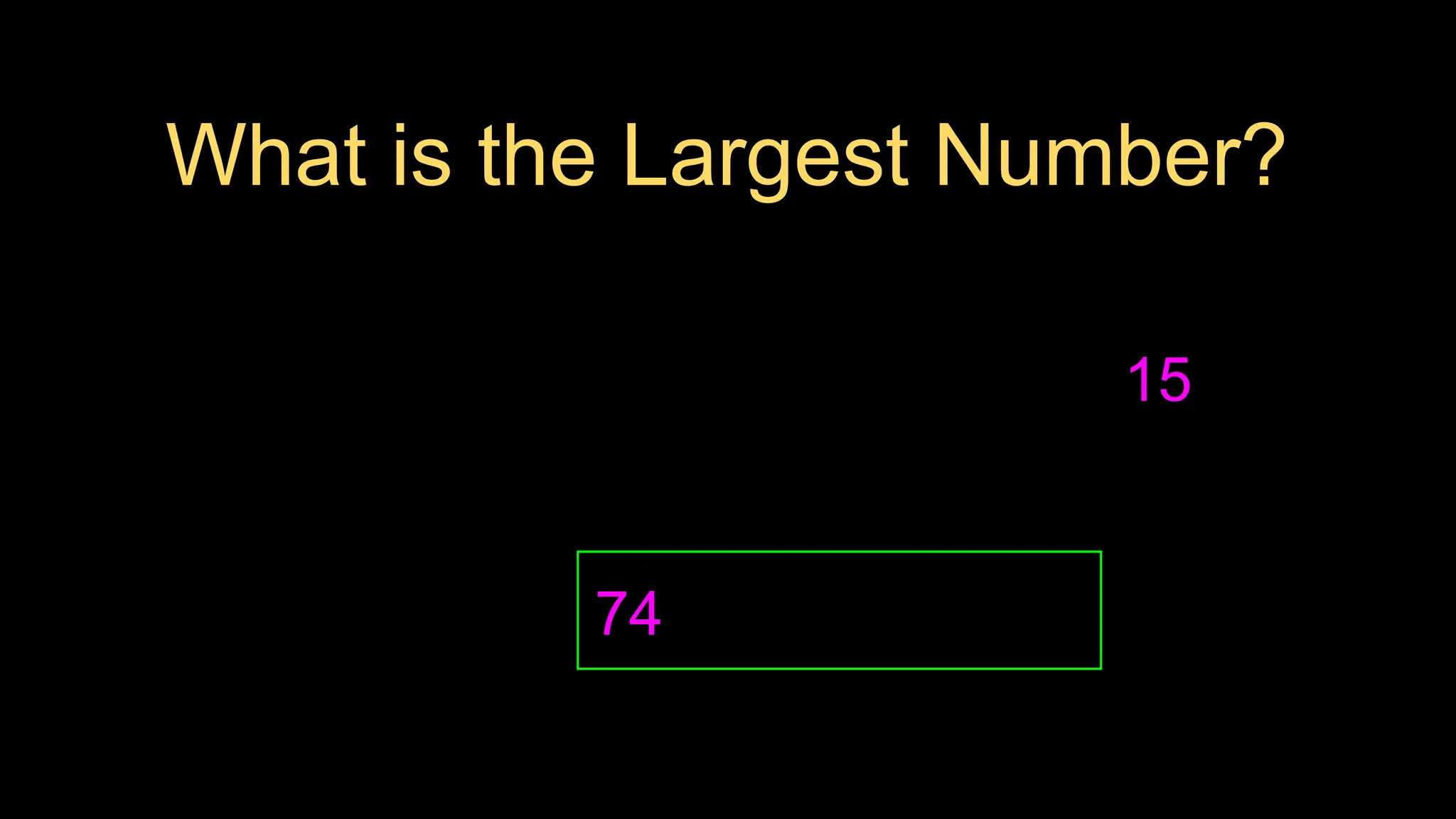
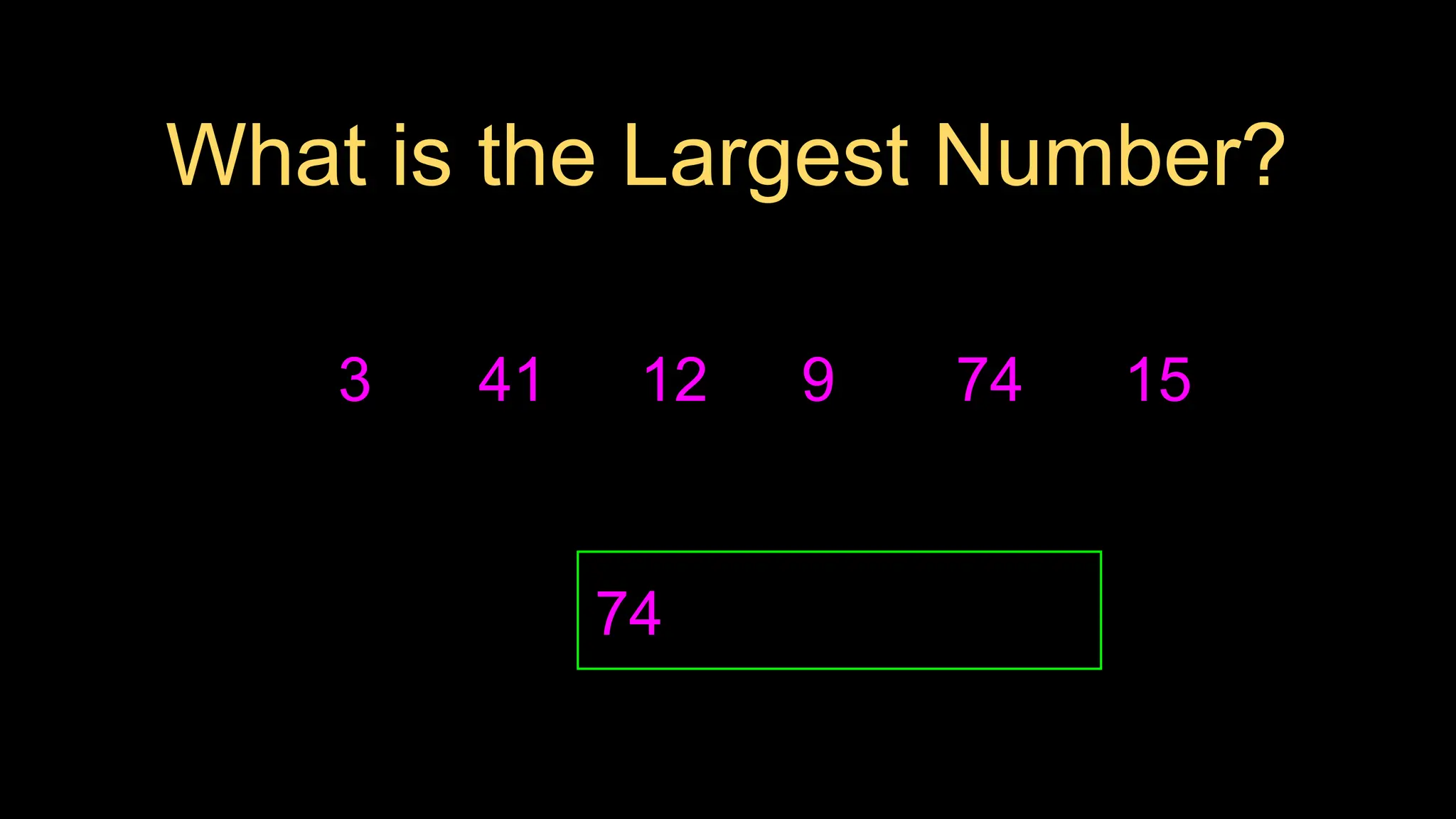
![Finding the Largest Value
largest_so_far = -1
print('Before', largest_so_far)
for the_num in [9, 41, 12, 3, 74, 15] :
if the_num > largest_so_far :
largest_so_far = the_num
print(largest_so_far, the_num)
print('After', largest_so_far)
$ python largest.py
Before -1
9 9
41 41
41 12
41 3
74 74
74 15
After 74
We make a variable that contains the largest value we have seen so far. If the current
number we are looking at is larger, it is the new largest value we have seen so far.](https://image.slidesharecdn.com/pythonlearn-05-iterations-241020153812-3ca8e48e/75/Pythonlearn-05-Iterations-Lecture-Python-40-2048.jpg)
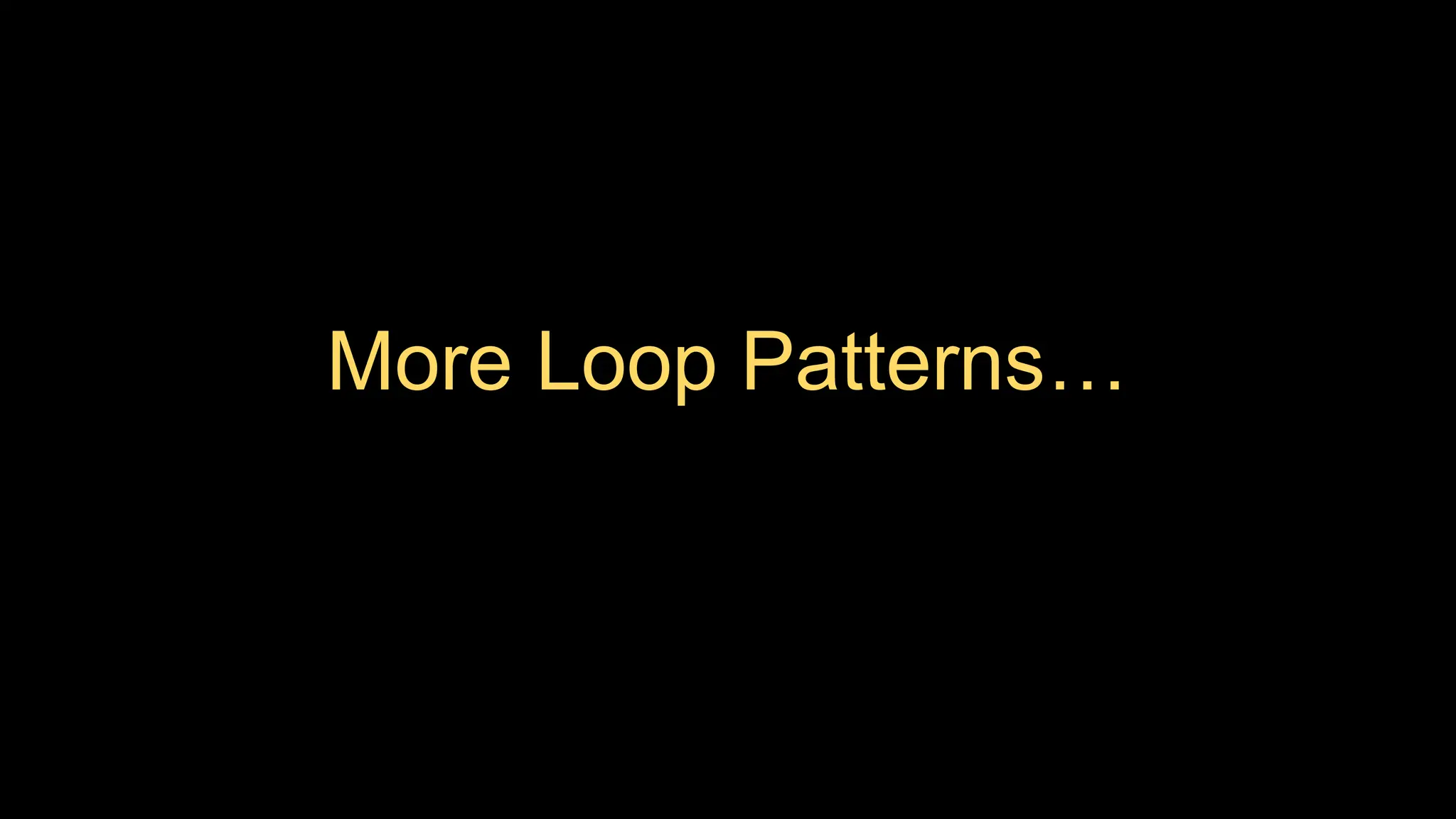
![Counting in a Loop
zork = 0
print('Before', zork)
for thing in [9, 41, 12, 3, 74, 15] :
zork = zork + 1
print(zork, thing)
print('After', zork)
$ python countloop.py
Before 0
1 9
2 41
3 12
4 3
5 74
6 15
After 6
To count how many times we execute a loop, we introduce a counter variable
that starts at 0 and we add one to it each time through the loop.](https://image.slidesharecdn.com/pythonlearn-05-iterations-241020153812-3ca8e48e/75/Pythonlearn-05-Iterations-Lecture-Python-42-2048.jpg)
![Summing in a Loop
zork = 0
print('Before', zork)
for thing in [9, 41, 12, 3, 74, 15] :
zork = zork + thing
print(zork, thing)
print('After', zork)
$ python countloop.py
Before 0
9 9
50 41
62 12
65 3
139 74
154 15
After 154
To add up a value we encounter in a loop, we introduce a sum variable that
starts at 0 and we add the value to the sum each time through the loop.](https://image.slidesharecdn.com/pythonlearn-05-iterations-241020153812-3ca8e48e/75/Pythonlearn-05-Iterations-Lecture-Python-43-2048.jpg)
![Finding the Average in a Loop
count = 0
sum = 0
print('Before', count, sum)
for value in [9, 41, 12, 3, 74, 15] :
count = count + 1
sum = sum + value
print(count, sum, value)
print('After', count, sum, sum / count)
$ python averageloop.py
Before 0 0
1 9 9
2 50 41
3 62 12
4 65 3
5 139 74
6 154 15
After 6 154 25.666
An average just combines the counting and sum patterns and
divides when the loop is done.](https://image.slidesharecdn.com/pythonlearn-05-iterations-241020153812-3ca8e48e/75/Pythonlearn-05-Iterations-Lecture-Python-44-2048.jpg)
![Filtering in a Loop
print('Before')
for value in [9, 41, 12, 3, 74, 15] :
if value > 20:
print('Large number',value)
print('After')
$ python search1.py
Before
Large number 41
Large number 74
After
We use an if statement in the loop to catch / filter the
values we are looking for.](https://image.slidesharecdn.com/pythonlearn-05-iterations-241020153812-3ca8e48e/75/Pythonlearn-05-Iterations-Lecture-Python-45-2048.jpg)
![Search Using a Boolean Variable
found = False
print('Before', found)
for value in [9, 41, 12, 3, 74, 15] :
if value == 3 :
found = True
print(found, value)
print('After', found)
$ python search1.py
Before False
False 9
False 41
False 12
True 3
True 74
True 15
After True
If we just want to search and know if a value was found, we use a variable that
starts at False and is set to True as soon as we find what we are looking for.](https://image.slidesharecdn.com/pythonlearn-05-iterations-241020153812-3ca8e48e/75/Pythonlearn-05-Iterations-Lecture-Python-46-2048.jpg)
![How to Find the Smallest Value
largest_so_far = -1
print('Before', largest_so_far)
for the_num in [9, 41, 12, 3, 74, 15] :
if the_num > largest_so_far :
largest_so_far = the_num
print(largest_so_far, the_num)
print('After', largest_so_far)
$ python largest.py
Before -1
9 9
41 41
41 12
41 3
74 74
74 15
After 74
How would we change this to make it find the smallest value in the list?](https://image.slidesharecdn.com/pythonlearn-05-iterations-241020153812-3ca8e48e/75/Pythonlearn-05-Iterations-Lecture-Python-47-2048.jpg)
![Finding the Smallest Value
smallest_so_far = -1
print('Before', smallest_so_far)
for the_num in [9, 41, 12, 3, 74, 15] :
if the_num < smallest_so_far :
smallest_so_far = the_num
print(smallest_so_far, the_num)
print('After', smallest_so_far)
We switched the variable name to smallest_so_far and switched the > to <](https://image.slidesharecdn.com/pythonlearn-05-iterations-241020153812-3ca8e48e/75/Pythonlearn-05-Iterations-Lecture-Python-48-2048.jpg)
![Finding the Smallest Value
smallest_so_far = -1
print('Before', smallest_so_far)
for the_num in [9, 41, 12, 3, 74, 15] :
if the_num < smallest_so_far :
smallest_so_far = the_num
print(smallest_so_far, the_num)
print('After', smallest_so_far)
We switched the variable name to smallest_so_far and switched the > to <
$ python smallbad.py
Before -1
-1 9
-1 41
-1 12
-1 3
-1 74
-1 15
After -1](https://image.slidesharecdn.com/pythonlearn-05-iterations-241020153812-3ca8e48e/75/Pythonlearn-05-Iterations-Lecture-Python-49-2048.jpg)
![smallest = None
print('Before')
for value in [9, 41, 12, 3, 74, 15] :
if smallest is None :
smallest = value
elif value < smallest :
smallest = value
print(smallest, value)
print('After', smallest)
$ python smallest.py
Before
9 9
9 41
9 12
3 3
3 74
3 15
After 3
We still have a variable that is the smallest so far. The first time through the loop
smallest is None, so we take the first value to be the smallest.
Finding the Smallest Value](https://image.slidesharecdn.com/pythonlearn-05-iterations-241020153812-3ca8e48e/75/Pythonlearn-05-Iterations-Lecture-Python-50-2048.jpg)
![The is and is not Operators
• Python has an is operator
that can be used in logical
expressions
• Implies “is the same as”
• Similar to, but stronger than
==
• is not also is a logical
operator
smallest = None
print('Before')
for value in [3, 41, 12, 9, 74, 15] :
if smallest is None :
smallest = value
elif value < smallest :
smallest = value
print(smallest, value)
print('After', smallest)](https://image.slidesharecdn.com/pythonlearn-05-iterations-241020153812-3ca8e48e/75/Pythonlearn-05-Iterations-Lecture-Python-51-2048.jpg)
